


WHERE OUR STORIES MEET




































It is with great excitement and pride that we invite you to experience the Canton Symphony Orchestra’s 2025–2026 season:Where Our Stories Meet. This year’s theme speaks not only to the music on our stage but to the process behind it—a season built on collaboration, shaped by the collective voices of our musicians, board members, and administrative team. It has been a joy to witness this organization come together in conversation, in planning, and in shared purpose to bring forth a season that reflects our deep commitment to artistic excellence while building connections within and beyond our community.









We are so glad that you have made the choice to join us here in Umstattd Hall to support live music in Stark County. Whether this is your first time here or you are one of our beloved subscribers, we thank you for joining us for this time of music making. As we welcome an incredible lineup of guest conductors, each bringing their own voice and vision to our stage, we also welcome the unique stories that come with them. Their perspectives offer us a rare and beautiful opportunity to see and hear the music we love in new and inspiring ways. This season will be rich with fresh interpretation, bold programming, and the unmistakable energy that comes from creative exchange.This season will be reflective of us all.
A huge thank you to our growing constituency of loyal subscribers, donors, single ticket buyers, and volunteers for your incredibly generous support. Without you, we truly would not be here. In addition, we would like to thank our orchestral musicians, choral musicians, and staff for all they do to put on these exceptional performances for our community, YOU!
We believe music is one of the most powerful ways to understand each other, to reflect on where we have come from, and to imagine where we might go together. We hope this season brings you joy, connection, and a sense of belonging—whether you are returning for your hundredth performance or joining us for the very first.
Please, sit back, relax, and enjoy another fabulous concert presented by your Canton Symphony Orchestra!





BOB PORTER Board Chair








VIRGINIA BANKS, MD | Member

LINDA CASEY | Member
SANDEE DOUGHERTY | Member
JOANNA ESCOBAR | Member
JENNIFER GEORGE | Member
PAT GILLESPIE | Member
ALISON JACOB | Member
JOE JADICK | Member
ELIZABETH GOOD KNUTSON | Member
JONATHAN LALEWICZ | Member
GAIL MARTINO | Member
MEG MATUSKA | Orchestra Representative
JOE OSTROWSKE | Member
BILLY PATTERSON | Member
COREY PAULUS | Member
BOB PORTER | President
DANNY PORTER | Member

ROBIN SEATON ROKISKY | Chorus Representative
MARK SHENGLE | Member
MELISSA SHIEPIS | Member
KATHY SMITHBERGER | Treasurer
JAY SPENCER | Member








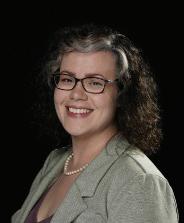



RACHEL HAGEMEIER President & CEO
Thomas pleban Librarian
Andrew junttonen Artistic Operations Manager
Rachael mosley Patron Relations & Office Manager
Caroline eberhard Director of Education & Community Engagement
Raylena Mae Bevington Canton Youth Strings Conductor and Director of the Saturday Strings Program
Matthew jenkins jarszewicz CYSAO Conductor







DOUGLAS BEERY Chorus Director
Sara dahler Marketing & Development Coordinator
Jennifer sloane Director of Finance
Nathan maslyk Director of Marketing & Development
Jodi hall Finance Assistant
Michele Monigold Conductor of the Intermediate Canton Youth Symphony
Rita haines Symphony League President






























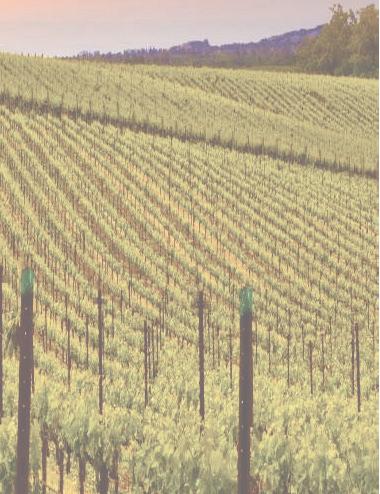



The Canton Symphony Orchestra (CSO), based in Canton, Ohio, was founded in 1937 and held its inaugural concert on February 16, 1938, under the direction of its first music director, Richard Oppenheim. This debut performance at the City Auditorium attracted an audience of approximately 3,300 people, featuring musicians made up of members of the community.
In 1949, Louis Lane, then Assistant Conductor of the Cleveland Orchestra, became the CSO’s second music director, initiating a tradition where Cleveland Orchestra assistant conductors would lead the CSO. Under subsequent directors, including Michael Charry and Robert Marcellus, the orchestra expanded its programming and community engagement. A significant milestone was achieved on June 2, 1974, when the CSO attained metropolitan status, elevating its profile beyond that of a community orchestra.
The Canton Youth Symphonies were established in 1961 to nurture young talent and introduce children to orchestral music. This initiative has grown to become a hallmark of the CSO’s educational programming, providing training and performance opportunities to over 100 students from 10 counties surrounding the region. Additionally, community engagement has been a cornerstone of the CSO’s mission, exemplified by the founding of the Symphony League in 1963. This auxiliary group provided critical fundraising and volunteer support for decades before its disbandment in 2020. Following a revitalization effort by Rita Haines-Albright in 2023, the Symphony League has since grown to 28 members strong today.
Gerhardt Zimmermann assumed the role of music director in 1980, a position he held with distinction until his passing in 2023. During his tenure, the CSO continued to grow artistically and operationally. A notable development was the opening of the Zimmermann Symphony Center on July 13, 2014, providing the orchestra with a dedicated facility that consolidated administrative offices and rehearsal spaces, enhancing its operational efficiency and community visibility being directly attached to McKinley High School.
Following Zimmermann’s passing, Matthew Jenkins Jaroszewicz, who had been serving as Music Director Designate since August 2020, assumed leadership as Music Director for the 2024-2025 season. His tenure, though brief, marked the beginning of a new era of collaborative music-making and artistic exploration, reinforcing the CSO’s commitment to innovation and engagement.
In 2025, Jaroszewicz announced his departure to pursue other endeavors, concluding his tenure as Music Director at the end of the season. With his departure, the Canton Symphony Orchestra looks ahead to a bright future, embarking on a national search for its next Music Director over the next two years. During this time, the CSO will welcome guest conductors from around the world, offering the community a rich and dynamic musical experience while seeking top-tier talent to lead the orchestra into its next chapter.

Richard Oppenheihm 1938 - 1949
Louis Lane 1949 - 1961
Michael Charry 1961 - 1974
Robert Marcellus (Music Advisor) 1974 - 1976
Thomas Michalak 1976 - 1980
Gerhardt Zimmermann 1980 - 2023
Matthew Jenkins Jaroszewicz 2023 - 2025

TBD


Sunday, S Sepptember 2 21, 2 2025, 4 4:00 PM A Chor us For a Cause Sunday, O October 2 26, 2 2025, 4 4:00 PM Baldwin Wallace Men’s Chor us with District 8 High School S Singer s



Dedicated to sharing the sense of awe latent within music and committed to engaging listeners with its contemporary relevance, Brooklyn-based conductor Alison Norris currently serves as the Conducting Fellow for the Canton Symphony—a position they won in 2024 and that has since been renewed and expanded for the 2025/26 season. Internationally, Norris has been invited as a guest conductor with the China International Philharmonic Orchestra in Beijing and conducted the Orchestre Métropolitain as a conducting finalist with Yannick Nézet-Séguin in Domaine Forget de Charlevoix. Recent festival engagements include Tanglewood’s Conducting Seminar, where they were invited to premiere a new work by Maya Miro Johnson, and the Cabrillo Festival of Contemporary Music as a Conducting Associate.
Sunday, N November 9 9, 2 2025, 4 4:00 PM OPUS 216 String Ensemble Sunday, F Febr uar y 22, 2 2026, 4 4:00 PM Dr. Emer y Stephens, Baritone
Always seeking to foster musical fascination alongside human compassion, in 2024 Norris organized a multidisciplinary benefit concert project entitled “Divinity and the Cosmos: A Genderqueer Exploration of Messiaen’s Turangalîla Symphonie”. They collaborated with five other transgender artists to create original films examining each movement of Messiaen’s preeminent work through a genderqueer lens: helping audiences navigate unfamiliar dissonances with the similarly enigmatic nature of trans joy.
Norris’s conducting mentors include George Manahan, Yannick Nézet-Séguin, Jim Ross, Cristian Măcelaru, and Oriol Sans. Alison holds a Professional Studies diploma from the Manhattan School of Music, a Masters of Music from UW-Madison, and a Bachelors of Science in Mechanical Engineering from Valparaiso University.
Cruz Stock (he/she/they) (b. 2004) is interested in composing music close to the human soul that takes the listener on an emotional journey. He aims to weave contemporary and traditional composition techniques into a colorful and rich human experience. She is currently pursuing degrees in both Composition and Instrumental Music Education at Bowling Green State University. Their composition teachers include Christopher Dietz, Piyawat Louilarpprasert, and Marilyn Shrude
Sunday, M Mar r ch 15, 2 2026, 4:00 PM Dr. Abigail Haake, Or gan Sunday, M May 3, 2026, 2 2:00 PM T he Canton Symphony Or chestr a Chor us Cathedral Concerts AT ST. PAUL ’ S




Sunday, S Sepptember 2 21, 2 2025, 4 4:00 PM A Chor us For a Cause Sunday, O October 2 26, 2 2025, 4 4:00 PM Baldwin Wallace Men’s Chor us


Founded in 1985 by Attorney Timothy J. Putman, Putman Properties, Inc. has been selling, leasing, listing and managing in the northeast Ohio commercial industrial and investment market for 40 years.
Joined in 1986 by Wick Hartung, the company today manages dozens of commercial and industrial properties. While celebrating 40 years, Spencer Hartung and Saylor Putman, the next generation are continuing the brokerage tradition. With 24/7 full-time property maintenance staff, we can handle managing, maintenance/repairs, estate properties and any other real estate challenges. Call us today!

















It takes a village. Volunteers are the life blood of this organization, and we could not do all that we do without your help! We value your time and service to our community. Your participation and feedback shapes this program!
Visit cantonsymphony.org/volunteer to learn more or contact me directly with any questions: Rachael Mosley, Patron Relations & Office Manager, rmosley@cantonsymphony.org, 234-666-2701.
You belong! There are a variety of ways to volunteer at the CSO from the concert hall to out in our community. Join us on POINT, a volunteer network, to find the perfect opportunity for you! pointapp.org/orgs/4060 Training is provided for every role, and our staff is always available to help. We can't wait to meet you
Fun Fact: Did you know that every hour of volunteering is valued at $34.79?

• Bartender *Must be 21 or over
• Community Representative
• Concert Greeter
• Guest Artist Driver *Must be 25 or over
• Office Aide
• Ticket Scanner/Ushers
• Will Call
• Instrument Petting Zoo
• Event Check In
• Door Guard User
• Parkings Guide
• And More!

• Merch Table & Concierge Table Concessions

It is important to recognize arts educators. Scan the code to nominate an educator today!

This award recognizes public, private, and parochial Music Educators in the region served by the Stark County Educational Service Center who have positively impacted their students and communities, and who have shown great dedication to the field of Music Education. The winner of this award will receive a $500 check.
Nominees must be licensed Music Educators in a public, private or parochial school classroom setting in Grades K-12, in the region served by the Stark County Educational Service Center. Educators from all fields of Music are eligible. The honored Educators will be selected from a field of five finalists chosen by a panel of qualified judges from the community. All nominees will be recognized at the presentation. Former recipients of the award are not eligible to win in consecutive years.


Anyone can nominate a Music or Art Educator for the award. While nomination forms are no longer available in person through the Stark County Educational Service Center, you can email Tom Piccari at tom. piccari@apps.sparcc.org.
Information for our partner Arts Educator of the Year Award can be found at the MassMu and the Canton Museum of Art’s websites. Music & Arts Awards will be recognized at the CSO’s performance of Brahm’s A German Requiem on March 28th, 2026. Winners will receive a $500 check and a performance or exhibit opportunity for their students
Sponsored by Michael & Judi Krew

FIRST VIOLINS
Konrad Kowal, Concertmaster
Fred F. Silk Chair
Emily Cornelius
Daniel M. and Maureen O. Gunn Foundation Chair
Jeremy Foster
Joseph & Arlene Gimigliano Chair
Yeji Kim
Jorie Butler-Geyer
Hadar Zaidel
Ruoyao Li
Lan Cen Shu
Ellie Kennedy
Ella Golden
Timothy Pinkerton
SECOND VIOLINS
Karen Ferry, Principal
The Schneider Chair
Margaret M. Matuska
Ryan Kearns
Abigail Macy
Sebastian Orellana
Erin Reidhead
Rebecca Rhoades
Abril Nuñez
Christine Black
Blake Armstrong
VIOLAS
Karen Wendel, Principal
Charlotte E. and Howard B. Weaver Chair
Gordan Liu
Thomas G. Pleban
Laura Kuennen-Poper
William Greenfield
CELLOS
Mingyao Zhao, Principal
Amelia S. and Donald J. Renkert Chair
Michael G. Koscso
Symphony League of Canton Chair
Nora Willauer
Matthew Rhee
Nathaniel Hoyt
Simone Pierpaoli
Fiona Tsang
Bryan Ping
Matthew Fields
BASSES
Thomas White, Principal
Richard S. and Helen M. Hoover Chair
Bob Kanel
Riley Zimmermann
Bryan Hieronymus
Alexander Carroll
Henry Samuels
Brian Del Bianco
HARP
Nancy Paterson, Principal
Murray MacCallum Bett, MD Chair

Jenny Robinson, Principal
Paul F. and Grace G. Vandervort Chair
Alexandra McGuire
Julie Johnson Sarver
PICCOLO
Julie Johnson Sarver
Rose and Lee de Graaf Chair
OBOES
Terry Orcutt, Principal
Robert L. Donna C. Leibensperger Chair
Cynthia Watson
Cynthia Warren
ENGLISH HORN
Cynthia Warren
Joan and Kennard Voyles Chair
CLARINETS
Matt Rosen, Principal
The T.K. & Faye A. Heston Chair
Alix Reinhardt
BASSOONS
Todd Jelen, Principal
Roberto Iriarte
FRENCH HORNS
Micah Northam, Principal
Joseph F. Jadick Endowed Chair
Brooke Boehmer
Benjamin Reidhead
Lisa Fink
TRUMPETS
Justin Kohan, Principal
Mark A. Raisner Chair
Kevin Natoli
Larry Herman
TROMBONES
Tom Pylinski, Principal
Andrew Mitchell
BASS TROMBONE
Sean McGhee
Listing as of 9/16/2025
TUBA
Tom Lukowicz, Principal
TIMPANI
John Curtis, Principal
Margaret B. Shipley, MD Chair
PERCUSSION
Alyson Rzeszotarski, Principal
Curtis G. and Matilda A. Kaltenbaugh Chair
Hunter Wirt
Sandra Frerichs Kramer Chair
Jeremy Sreejayan
KEYBOARD
Dean Zhang
Chelsea L. and Courtney S. MacNealy Chair
ARTISTIC OPERATIONS MANAGER
Andrew Junttonen
LIBRARIAN
Thomas G. Pleban
STAGE MANAGER
Zach DePinto


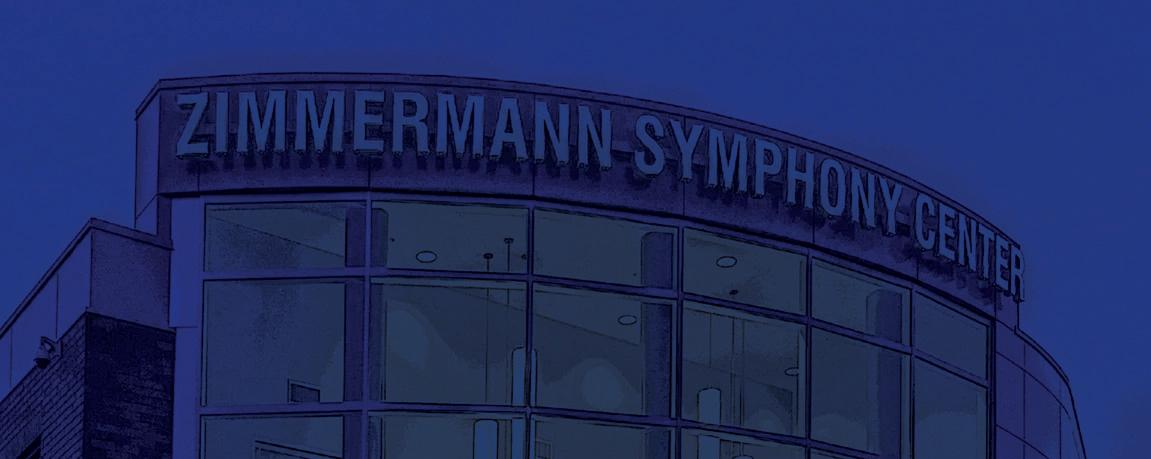
The Symphony League of Canton meetings take place every third Thursday at 5:30pm as follows:
September 17, 2025
October 16, 2025
November 20, 2025
December 18, 2025
January 15, 2026
February 19, 2026
March 19, 2026
April 16, 2026
May 21, 2026
June 18, 2026
Meetings take place in the board room within the CSO Administrative office and will also be held on Zoom for those who can only join remotely. For the Zoom link, please email league@cantonsymphony.org

The Symphony League of Canton is a non-profit educational membership association that exists to provide financial and volunteer support for the Canton Symphony Orchestra and to foster appreciation for finer music by developing, promoting, and supporting CSO programs and activities, particularly its educational and youthoriented programs.
The Symphony League of Canton meets on a monthly basis to discuss fundraisers, event volunteering needs, and brainstorm ways to support the Canton Symphony Orchestra.
• Robert Scharver
• John & Marcella Emmons
• Darla Kot
• Nancy A. Saulnier
• Melissa Shiepis
• Sara Marulli




After the first Symphony League of Canton meeting, it was decided that there would be two forms of membership: Active and Sustaining. Any member of the Symphony league will be listed in the season program book separately from the annual fund.
Active Members are expected to attend most scheduled meetings, volunteer at a reasonable number of events (3/5 MasterWorks, 2/3 Pops), and help with gathering raffle materials. They receive two tickets to every event they sign up to volunteer and receive a 30% discount to all other events (except the Divergent Sounds Series.)
• Running the raffle basket table for concerts
• Helping gather materials for raffle baskets and other fundraising items
It is important to recognize arts educators.
• Plan upcoming fundraisers
• Maintain snack table for musicians
Sustaining Memberships
Sustaining Members do not need to attend meetings but want to publicly be acknowledged as supporters focused on providing services to the orchestra musicians. They would be expected to attend at least 2 meetings per year and volunteer at at least 2 events, but these are not requirements. They receive two tickets to every event they sign up to volunteer and receive a 30% discount to all other events (except the Divergent Sounds Series.)
• Sharon Luntz
• Leah Michalos
• Scott & Elsie Oelslager
• Nancy Savage
• MJ & Pat Albacete
• Nancy Hoover
• Jay Spencer
• Toni Cotopolis
• Rita Haines
• Elizabeth Eynon
• Robin Rokisky
• Kayla DeVitto
BECOME A MEMBER!




















The Gerhardt Zimmermann Memorial Fund
Kenneth Shafer
Jan & Roger Baker
Larry & Nancy Hoover
Ralph & Joan Leidy
Linda & Leo Casey
Bill & Pearl Lemmon
Bob Leibensperger
Brad & Sue Goris
David Jones


Sharon Luntz


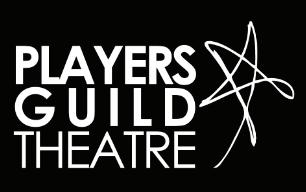





The Canton Symphony Orchestra is grateful to:










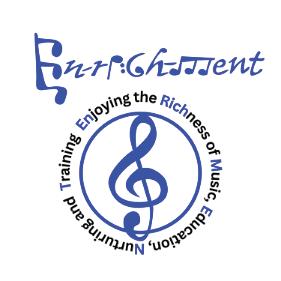




• The Cope Family for the Steinway concert grand piano given to the CSO in memory of Kenneth B. Cope.
• The CSO volunteers who give their time and talent so generously.
• The family of Kenneth C. Viant, who has generously given to the Kenneth C. Viant Memorial Research Library.
• Steinway Gallery who have provided pianos for our guest artists.



A bequest is a gift provision in your will or revocable living trust. All assets, including cash, securities, real estate, and tangible personal property, may be transferred to the Canton Symphony Orchestra at the end of your life.
One of the simplest ways to make a gift to the Canton Symphony Orchestra is to designate the CSO to receive your assets at the end of your lifetime. You can specify all or a percentage of the assets you want each beneficiary to receive. Often, it’s as easy as filling out a form.
Beneficiary designations are an option for giving the following financial assets:
• Retirement Assets
• Life Insurance
• Donor Advised Funds
• Annuity Contracts
• Bank Accounts
• Investment Accounts
Questions? Reach out to Nathan Maslyk at (234) 666-2710 or nmaslyk@cantonsymphony.org





By donating to the Canton Symphony Orchestra at any level, your generosity ensures that what you love about the CSO will be available to future generations. Every single dollar counts towards the health and sustainability of this fine organization.

Philanthropy plays a pivotal role in the sustenance and growth of an orchestra, ensuring its enduring impact on the cultural fabric of our community. By choosing to contribute, individuals make a lasting commitment to the preservation and advancement of musical excellence for future generations in Stark County.

Donating to the CSO empowers individuals to become custodians of musical heritage, ensuring that we remain an enduring force in the ever-evolving world of music.
Nathan Maslyk
Dear CSO Patrons,
As we embark on our 2025–2026 season, Where Our Stories Meet, I am reminded that every note of music we perform is part of a larger story—one that we create together. Your support has not only carried us through times of change, it has fueled our growth and brought us ever closer to resolving our nearly $200,000 deficit. This is a remarkable achievement, and we are profoundly grateful for the generosity that makes it possible.
Looking ahead, I invite you to consider how your story might continue alongside ours through Legacy Giving. A planned gift—whether through a charitable trust, endowed chair, donor-advised fund, or another option—provides a meaningful way to ensure the Canton Symphony Orchestra endures for generations to come. Legacy Giving is more than a contribution; it is a lasting chapter in the symphony’s history, sustaining the music you love and deepening the benefits we continue to provide the great community of Stark County.
Sincerely,

Nathan
maslyk Marketing & Development Director


Corporate and individual sponsors are the backbone of the CSO. Thanks to their generous support, we are able to present programming of the highest artistic and educational quality while preserving classical music in Stark County. Every year,


nmaslyk@cantonsymphony.org









Giving

Endowed Chairs
Gerhardt Zimmermann Memorial Fund Annual Fund Parking Fund

At Canton Symphony Orchestra, we rely on our dedicated donors to help us create, sustain, and grow our programs. When you make a gift to our annual fund, you are providing unrestricted operating support for our programs and access to exceptional orchestral music and arts education in our community.
Our individual donors who contribute to the CSO's annual fund receive benefits when their gift is $50 or more. All giving levels include the benefits listed in the level(s) before them.
At Canton Symphony Orchestra, we rely on our dedicated donors to help us create, sustain, and grow our programs. Did you know that only about one fifth of our budget is supported by ticket sales? When you make a gift to our annual fund, you are providing unrestricted operating support for our programs and access to exceptional orchestral music and arts education in our community.
PRELUDE CIRCLE - Gifts $50 to $249
Listing in the program book | Invitation to an open rehearsal
CONCERTO CIRCLE - Gifts $250 to $999
Pair of ticket vouchers good for any performance | Single-Ticket Pre-Sale
VIRTUOSO CIRCLE - Gifts $1,000 to $2,499
CD/Download of special Canton Symphony highlight recordings | Invitation to season “Sneak Peak”
MAESTRO CIRCLE - Gifts $2,500 to $9,999
Invitation to private happy hour and open rehearsal with the CEO | Invitation to annual meeting and dinner with performance
GOLDEN BATON - Gifts $10,000 to $19,999
Premium reserved parking | A private dinner with the Conductor, CEO, and/or a musician of their choice
PLATINUM BATON - Gifts above $20,000
Benefits are tailored to each individual
*All tiers include previous level benefits. All Benefits Optional.


Edith Gordon Ainsberg
Susan M. Anderson
In Memory of Janet S. Barone
Dr. Richard W. Belcher
Nancy Blair
Rachel B. Blair
William P. Blair III
In Memory of Alan Blau
Estelle Wilkof Blau
In Memory of Sally Jackson Brooks
In Memory of John F. Buchman III
Jane Purdy Cable
C. L. Carver II
In Memory of Margaret Cirone
Harland R. Clapper
In Memory of Polly J. Clouser
In Memory of Rose Van Til de Graaf
Russell D. and Agnes E. Dougherty
C. E. Dougherty
From the Janet C. Fisher Endowment
In Memory of Grace Tate Ewing
Suzanne and Herman G. Fisher
Peggy Fitzmaurice
Albert W. and Edith V. Flowers
Mrs. Wayne Frederick
In Memory of Ralph C. and Betty K. Frerichs
Arthur E. Gibbs
Mildred S. Gibbs
Richard A. Gibbs
In Memory of Margaret Giglio
In Memory of Joan Gillespie
In Memory of Joe Gimigliano
Kathleen Hickey Green
Robert V. Haas
Thomas & Margaret Hague
In Memory of Robert H. Higginbotham




In Memory of James E. Hiltner
In Memory of Norman J. Kamen
In Memory of Matilda A. Kaltenbaugh
Dr. Adib H. Karam
In Memory of Pete Keplinger
Edward T. & Justine A. Krane
Maurice P. Lape
James Lehberger
In Memory of Donna Leibensperger
Abraham and Mina Levie
Stanford Linde
Charles Luntz
In Memory of William A. Maddox
In Memory of Steve Malycke
Michael and Etta Martin Family
James E. McCort
Rosalie S. McCort
In Memory of Helen McInnes
Richard C. Mellon
In Memory of Linda V. Moorhouse
In Memory of Virginia W. and W. J. Moorhouse
Maisie Peterson
Giles B. J. “Gil” Raisner Jr.
Mark A. Raisner
In Memory of Dr. Samuel S. and Celia G. Reinglass
Amelia S. and Donald J. Renkert
Rachel Fisher Renkert
Dr. Fabio and Trinidad Rodriguez
Theodore Savastano
Mary Alice Saxton
James M. Sayers
In Memory of Richard M. Schneider
Fred F. Silk
Joan Shaheen
Larry and Ginny Smerglia
E. Kathleen Smith
Tanzy J. Smith
Jacob and Theodosia Soehnlen
Viorel Stefan
Herman L. and Ethel M. Summers
Dr. Dale C. and Margaret R. Swallen
William D. Taylor
In Honor of Mason J. and Charlotte A. Thompson
In Memory of Kenneth C. Viant
In Memory of Kennard Everett Voyles
In Memory of Lt. Col. David L. Watkins
In Memory of Thelma Bechtel Watkins
In Memory of Charlotte Weaver
Dr. H. B. Weaver Family Endowment Fund
Dr. Frank & Saragale Weinstock
John C. and Bernice E. Werren
In Memory of Raymond Wilkof
Samuel G. Wilson
Mr. and Mrs. Arlin Mills Woody
In Memory of Dennis Andrew Young, M.D.
In Memory of Mary Zawacki
Carole J. Zimmerlin
You may wish to honor people on special occasions or memorialize relatives or friends with a contribution, in any amount, to the Canton Symphony Orchestra’s Rhapsody Remembrance Fund. Living Tributes are established with an accumulation of gifts totaling $500.






Endowing a Canton Symphony Chair is an opportunity to make a major contribution to the Symphony in perpetuity, and at the same time honor a loved one, establish a memorial, or recognize a member of the community who has made an important contribution to civic life. Named Canton Symphony Chairs are listed in the program book within the orchestra roster for each performance. Several chairs of the Canton Symphony are available for endowment. The principal bassoon, trombone, and tuba are accessible to many with financial and estate planning. Talk to your advisor today and join the many donors who support the Orchestra’s future. To learn more about ways to secure your legacy, see page 13.
Those interested in more information may contact Rachel Hagemeier at 234-666-2703 or rhagemeier@cantonsymphony.org.
The current Endowed Chairs of the Canton Symphony Orchestra:
Music Director Renkert Family Chair
Assistant Conductor
Grace Hofsteter, MD Chair
Associate Conductor
William P. Blair III Chair
Concertmaster
Fred F. Silk Chair
First Violin, Second Chair
Daniel M. and Maureen O. Gunn Chair
First Violin, Third Chair
Joseph & Arlene Gimigliano Chair
Principal Second Violin
The Schneider Chair
Principal Viola
Charlotte E. & Howard B. Weaver Chair
Principal Cello
Amelia S. & Donald J. Renkert Chair
Cello, Section
Symphony League of Canton Chair
Principal Bass
The Hoover Family
Principal Flute
Paul F. & Grace G. Vandervort Chair
Piccolo
Rose and Lee de Graaf Chair
Principal Oboe
Robert L. & Donna C. Leibensperger Chair
English Horn
Joan & Kennard Voyles Chair
Principal French Horn
Joseph F. Jadick Chair
Principal Clarinet
The T. K. and Faye A. Heston Chair
Principal Trumpet
Mark A. Raisner Chair
Principal Harp
Murray MacCallum Bett, M.D. Chair
Principal Percussion
Curtis G. & Matilda A. Kaltenbaugh Chair
Percussion, Section
Sandra Frerichs Kramer Chair
Principal Timpani
Margaret B. Shipley, M.D. Chair
Keyboard
Chelsea L. & Courtney S. MacNealy Chair
Additional Chairs available for endowment:
Principal Bassoon
Principal Trombone
$70,000
$70,000
Principal Tuba $70,000
Any Section Chair $35,000 (58 available)
WHAT SHOULD I WEAR? - There is no dress code for Canton Symphony Orchestra performances. Patrons wear anything from jeans to business attire to formal. We think you should wear whatever you feel comfortable in for a night out!
WHEN SHOULD I ARRIVE? - Plan to arrive at least 30 minutes before the concert start time. This will give you enough time to park, find your seat, look over the program, and relax before the music begins.
I DO NOT KNOW WHEN TO CLAP! - Don’t worry! We like it when the audience claps. It makes us feel like we are doing a good job. Clap when the music ends and you like what you hear! The conductor will ask the audience to hold their applause during a multi-movement work.
HOW LONG WILL THE CONCERT RUN? - Our concerts vary in length depending on the music being performed. Most concerts last between ninety minutes and two hours, including one intermission.
HOW LONG IS INTERMISSION? - For Canton Symphony Orchestra performances, intermission generally runs twenty minutes. This may vary for certain kinds of performances. The lights in the lobby will flash shortly before the end of intermission.
Pre-concert Lectures - Prior to all MasterWorks concerts, we feature a preconcert lecture, which is free to all ticket buyers. All talks occur one hour before the concert in The Martino Bar. These discussions provide a more indepth look into the music performed that evening and give concertgoers more to listen for during the concert. Lectures will be hosted by MJ Albacete. The Martino Bar - Formerly known as Club Z, The Martino Bar is open to all ticket buyers one hour prior to the performance and again at intermission. While most of us are NOT mixologists, we feature a full bar including liquor, wine, and beer. Light concessions are also sold. Please note, only water may be brought into Umstattd Hall.
The Hoover Family Gallery - This gallery is a space where artists and music come together to bring the auditory world into the visual world. It is home to our Artist in Residence program, which was established in 2021 to provide a commissioned opportunity for local artists. Their pieces are then displayed in The Larry & Nancy Hoover Gallery all season-long for patrons to enjoy. At the end of the season, the artwork is auctioned off at our summer fundraiser!

GROUP DISCOUNTS - Available for groups of ten or more for any concert. Please contact the Box Office for more information.
CHILDREN/STUDENTS - Both children under 18 and adults currently enrolled at either a college, university, or trade school may attend any concert within the MasterWorks series at no cost. Redeem over the phone, by visiting our box office, or purchase at the door day-of-concert.
GIFT CERTIFICATES - Available year-round in a variety of denominations and may be redeemed for any Canton Symphony Orchestra concert.
OTHER DISCOUNTS - Veterans, First Responders, Healthcare Workers, & Educators: 20% off
SNAP & Medicaid Recipients: 20% off
We provide multiple ways to order, so you can purchase your tickets through the medium that is most convenient for you. A $15 fee will be applied per subscription and a $3 fee per single ticket. Fees help cover the costs associated with our ticketing software, facility maintenance, parking staff, security personnel, and credit card processing fees.
ONLINE – Order 24/7 and choose your own seats on our secure website. Tickets are mailed, held at Will Call, or sent to your email so you can show us on your phone. All tickets must be scanned to gain entry.
By Phone – Call the Box Office at (330) 452-2094. If you are prompted to leave a message, please do so and we will return your call within one business day.
in person – Zimmermann Symphony Center 2331 17th Street NW, Canton, OH 44708
*Office Hours, closed from 12-1pm for lunch* Monday: CLOSED Tuesday – Thursday: 9am – 5pm. Friday (summer only): 9am – 1pm.

At the door – The Box Office at Umstattd Hall opens one hour prior to each event.










Douglas Beery is the Director of Choral Activities at Hoover High School in North Canton, Ohio, where he leads eight choirs, including recently established Men’s and Women’s Choruses. Under his direction, Hoover ensembles have consistently earned superior ratings at OMEA District and State Adjudicated Events. Previously, he directed choirs at Northwest High School and Massillon Washington High School, expanding both programs significantly and earning numerous accolades, including Northwest’s “Teacher of the Year” (2017), Stark County “Teacher of the Year” finalist (2018), and Canton Symphony Orchestra “Music Educator of the Year” finalist (2020).
With more than twenty years of experience, Mr. Beery has held graduate conducting appointments at The Ohio State University and Kent State University, and has conducted ensembles across Ohio, the U.S., and Europe. He has also directed over twenty Broadway musical productions. He holds a Bachelor of Music degree from Capital University and a Master of Music in Choral Conducting from The Ohio State University, with additional doctoral and graduate study at Kent State, the University of Michigan, and Miami University. Active as a guest conductor, adjudicator, and presenter, Mr. Beery is also a longstanding member of ACDA and OMEA. He looks forward to making music with the Canton Symphony Chorus in the coming years.



Permanently founded in 1983 by then-director Dr. Jeffrey H. Brandes, the CSO Chorus is an auditioned choral ensemble composed of all volunteer vocalists from the greater Stark County area. Chorus members come from all walks of life and have a wide array of choral experience levels. They are united in their love for music and strive for remarkable music experience for not only the audience, but also themselves.
The CSO Chorus appears several times throughout the season with the Canton Symphony Orchestra, and has begun pursuing some chorus-only concerts. They practice on Monday evenings from September through May from 7:00pm-9:30pm at the Birk Center within Walsh University. Auditions are held periodically throughout the season.
The view from the top of the stage, looking out towards the audience over a 60-piece orchestra is indescribably profound. Members of the chorus are able to sing with not only the Canton
Symphony Orchestra, but also with some of the industry’s most renown soloists and ensembles. Members have plenty of instruction and support to prepare for more difficult pieces, as some concerts feature choral parts in different languages such as German, Italian, French, and more. The group is not just a supplemental piece to the CSO – it is its own community program that is meant to educate and support vocalists looking for a place to sing.
Singing in a chorus is a powerful art form that not only has the ability to enhance your vocal abilities, but it also provides numerous mental and physical benefits that contribute to your overall well-being and health. In fact, singing in a chorus can have a transformative impact on your life.
If you have any questions about joining the chorus please reach out to us by emailing Douglas Beery, Director of Chorus at dbeery@cantonsymphony.org







Grades: 1-5
Dates: October 8 & 9, 2025
Times: 9:45 & 11:15am each day


Location: Umstattd Hall
Zimmermann Symphony Center Focus: Music/Dance/ELA
Get ready for a wildly entertaining mashup of music, movement, and mystical characters!
The Canton Symphony Orchestra and Canton Ballet are teaming up for a show that’s equal parts epic and enchanting: Peter and the Wolf! Since 1978, Canton Ballet has been delighting audiences with this classic tale, pirouetting its way into the hearts of thousands of children across Northeast Ohio. Paired with the Canton Symphony Orchestra’s beloved Young People’s Concerts, this dynamic duo is giving kids their first unforgettable memory of live ballet and symphonic storytelling. In this collaborative performance, students won’t just sit back and watch—they’ll learn about music, movement, and the art of bringing stories to life. Will Peter and his animal friends outwit the Wolf and save the day? There’s only one way to find out…
Join us and leap into a live-action fairytale where every note and twirl tells a story!
Grades: Pre-K-1



Strings: January 17, 2026
Location: Stark Libraries Woodwinds: February 7, 2026
Focus: Music Brass: March 7, 2026
All performances presented at 10am and 11am
Enjoy three trio concerts that will introduce students to the different families of the orchestra! Classical musicians will perform, introducing attendees to the world of orchestra music in an interactive way. The program includes a musical story time and allows children to explore various instruments.
Recommended for children ages 3-6, but siblings of other ages welcome! Registration is required and space is limited. Reserve in advance!
Grades: Pre-K - 2
Dates: April 15 & 16, 2026
Times: 9:45am & 10:45am each day



Location: Canton Cultural Center for the Arts Great Court Focus: Music/ELA
In a land not so far away — right in the heart of Canton — 30 musicians and a conductor dreamed of creating the most beautiful music, and sharing the wonders of the orchestra with young adventurers like you!
Join the Canton Symphony for “Once Upon an Orchestra”, a fun-filled, fairytale-themed concert where storytelling springs to life through the sounds of a live orchestra. Journey through enchanted forests, royal castles, and mythical lands as music makes legends leap off the page. Along the way, you’ll meet the four fantastical families of the orchestra. With music inspired by fairytales, folklore, and legends from around the world, this interactive and imaginative concert invites children to explore how an orchestra tells stories, stirs emotion, and inspires wonder — all through the power of sound.




My name is Caroline Eberhard, and I am the Director of Education and Community Engagement for the Canton Symphony Orchestra. From enchanted fairytales to soaring myths and the rhythmic magic of folklore, the 2025–2026 Canton Symphony Orchestra Education Season invites students, families, and educators on a musical journey through wonder and legend. We introduce to you our season theme of Fantasy & Folklore! With spellbinding collaborations and storytelling through sound, each performance will open a portal to the imagination. Most programming is free and will feature connections between music, fantasy, fairytales, and folklore from around the world. Together, let’s explore our common values like kindness, perseverance, and community in a way that’s fun, inclusive, and deeply educational.
Every season, we offer at least two full orchestra concerts to schools. First up are the Young People’s Concerts, this year in collaboration with Canton Ballet, where we will jointly present Peter & the Wolf. These performances will provide students grades 15 with their first unforgettable memory of live ballet and symphonic storytelling. The Kinder Concert(s) titled “Once Upon an Orchestra” is designed for Pre-K-2 grade and will introduce students to the families of the orchestra and classical music in conjunction with lessons about ELA and classic tales! All educational concerts blend musical learning with the Ohio Learning Standards as established though the Ohio Department of Education. Within the education season brochure and on our website, you will find the many educational opportunities offered to schools, students, and families. Some such programs include SymphonyLand, Listen @the Library, Saturday Strings, Canton Youth Symphonies, Backyard Explorations, Mindful Music Moments, and more!


Lighthouse Ministries has been serving the youth of Southeast Canton since 1996. They provide a safe place for neighborhood children to learn and grow through after-school programs, ministry clubs, summer activities and acts of service. Today the Lighthouse employs 15 people and has a volunteer base of more than 40 individuals. Programming includes the After School Program with 40 children attending daily, which includes tutoring and homework assistance as well as time for enrichment and recreation. They also offer the Summer Activities Project, the Summer Enrichment Program and Youth Ministry Clubs for all ages. The Lighthouse Ministries Saturday Strings program is a free strings training program provided to students in the Lighthouse Ministries after-school program in Southeast Canton. The mission of this program is to provide free, high quality lessons and instruments to students, making musical learning a more accessible and equitable experience.



I am moved by the strength and compassion of Stark County and the surrounding communities. It is a great honor to be a part of such a wonderful, thriving, and passionate family, and I hope that the programming we offer continues to serve the needs of your students and make lasting musical impressions. We cannot wait to learn with you!
CAROLINE EBERHARD Director of Education & Community Engagement





The Canton Symphony Orchestra has partnered with The Well to bring “Mindful Music Moments” to Stark County Schools. A Mindful Moment’s mission is to improve the mental and emotional well-being, connectedness, and effectiveness of all persons through arts integration, mindfulness, music, movement, and healing-centered practices.
Mindful Music Moments is a U.S.-based program designed to provide a daily mindfulness prompt followed by 3 minutes of classical music from our world-class orchestra partners as a way for staff & students to find a moment of stillness and focus before and/or during the school day.
In 2024-25, the program was used by 320 PreK-12 schools, reaching 135,000+ students! This program provides a Tier 1 PBIS experience for all and helps students with self-awareness and selfmanagement (CASEL) to have the capacity for higher learning and cooperation.

The Canton Youth Symphony was founded in 1961 as a way to give young musicians the opportunity to participate in a high-quality regional youth orchestra that strives to provide a professional atmosphere for music making and the highest artistic standards. The Canton Youth Symphony is meant to supplement, not replace, school instruction and ensemble participation. (Need-based tuition scholarship is available!)
Questions? For more information, contact Caroline Eberhard, Director of Education & Community Engagement at ceberhard@cantonsymphony.org.
Youth Strings
Beginning and Intermediate String Players
Mondays: 6:30pm-7:30pm
2025-26 Tuition: $120/year or $45/cycle (3 cycles/ year)


Canton Youth Symphony
Full Orchestra for Intermediate Players
Mondays: 6pm-8:30pm
2025-26 Tuition: $215/year or $75/ cycle (3 cycles/ year)
Canton Youth Symphony Advanced Orchestra
Full Orchestra for Advanced Players
Mondays: 6pm-8:30pm
2025-26 Tuition: $215/year or $75/ cycle (3 cycles/ year)
Missed auditions in the fall? Mid-season auditions are accepted year-round! Email ceberhard@cantonsymphony.org to schedule yours!



Raylena Bevington Youth Strings Conductor



Michele Monigold CYS Conductor



Matthew Jenkins Jaroszewicz
Canton Youth
Symphony Advanced Conductor

Discover the new sound when two different musical genres are combined into one unique concert experience. Hear Canton Symphony Orchestra musicians perform with some of the region’s most popular artists. Concerts regularly sell out, so make sure to get your tickets early! Tickets are $20 and are available online or at the door. For all performances, doors open at 7:00pm and the show starts at 7:30pm.
Located at The Auricle - Venue and Bar
Thursday, September 25th, 2025 - 7:30PM
Kid Tigrrr is the ethereal solo project of Cleveland-based singer-songwriter Jenna Fournier, known for her blends dream pop, indie folk, and art rock to explore themes of identity and healing through lush, self-produced soundscapes.



THE SYMPHONY
Thursday, October 23rd, 2025 - 7:30PM
The G. Sirak Band is a Cleveland-based musical ensemble led by Gary Sirak, a financial services veteran and author. The band blends storytelling with a mix of pop, rock, and Americana influences, offering a fresh perspective on life’s experiences.
SYMPHONY
Thursday, January 29th, 2026 - 7:30PM
Apostle Jones is a dynamic soul band that bends styles and genres to create a uniquely collaborative, fresh sound. Pulling from collective influences of Rock, R’n’B, Blues, Gospel and Funk, Apostle Jones soars with original music, serves crowd pleasers and spreads a contagious joy for their hometown Cleveland, OH.
marc lee shannon Meets the Symphony





Thursday, March 19th, 2026 - 7:30PM
Marc Lee Shannon is an Akron-based singer-songwriter, guitarist, and author known for his 25-year tenure with Michael Stanley’s band, The Resonators. A seasoned session musician, Shannon has released four solo albums.
Thursday, May 21st, 2026 - 7:30PM
What started as a pandemic related distraction from boredom for these siblings, COMPASS has become a tight band of melodic, heart-pulling, guitar driven indie rock music.




Presented By Sirak Financial in Partnership with The Summit FM








Presented By
Co-Sponsored By
Participating Sponsor



October 4, 2025 - 7:30pm














WESLEY SCHULZ
MENG SU - GUITAR
El sombrero de tres picos, Suite No. 1 - 10 Minutes
Manuel de Falla
Concierto de Aranjuez - 22 Minutes
Joaquín Rodrigo
Intermission - 20 Minutes
Overture to The Marriage of Figaro - 4 Minutes
W.A. Mozart
Symphony No. 4 - 32 Minutes

Ludwig van Beethoven

Meng Su is a multifaceted guitarist renowned for her virtuosic skill and refined artistry, captivating audiences worldwide. Praised for her “seemingly effortless and stunningly polished” performances (New York Concert Review), she is recognized as a seasoned artist with a striking stage presence. As a soloist and chamber musician, she regularly performs with orchestras and as part of the acclaimed Beijing Guitar Duo. She has appeared in over 30 countries at major venues including the Concertgebouw, Palau de la Música, Tchaikovsky Hall, and Beijing’s National Centre for the Performing Arts. In 2023, she premiered Spanish Fantasia in Shanghai—the first multimedia guitar theatre production of its kind.
Her recordings have garnered international acclaim, including a Latin Grammy nomination for her duo’s debut album Maracaípe. She has released several celebrated albums, including Bach to Tan Dun and her solo debut Meng, hailed as “awe-inspiring” by Classical Guitar Magazine. Born in Qingdao, China, Meng Su began studying guitar at age five under Prof. Chen Zhi and later studied with Maestro Manuel Barrueco at the Peabody Conservatory, earning multiple advanced degrees. A winner of numerous international competitions, including the prestigious Parkening International Guitar Competition, she now teaches at the San Francisco Conservatory of Music and serves as Artist-in-Residence with the Baltimore Classical Guitar Society.
Widely recognized for his imaginative programming and spirited yet heartfelt music making with orchestras, Wesley Schulz’s conducting has been deemed “spectacular.” Schulz is Music Director and Conductor of the Auburn Symphony Orchestra (WA) and was formerly the Associate Conductor of the North Carolina Symphony. As a guest conductor, Schulz has appeared with the Seattle, Utah, Austin, Tallahassee, Canton, Williamsburg, Greenville, Richmond (IN), Waco, and Bozeman Symphony Orchestras among many others. Schulz is Principal Guest Conductor at the Pacific Northwest Ballet having led productions such as Prokofiev’s Romeo and Juliet as well as annual performances of Tchaikovsky’s The Nutcracker.
Key to Schulz’s success is his passion for diversifying classical music and expanding the concert hall to include all listeners. He has collaborated with some of the most dynamic musical artists of our time including Tessa Lark, Leslie Odom Jr, John Williams, Philippe Quint, Bella Hristova, Richard Lin, Pink Martini, Randall Goosby, Cirque de la Symphonie, Amos Lee and many more. When not on the podium, Schulz enjoys CrossFit, snowboarding, cooking and playing endless fetch with his two dogs, Chewbacca and Han Solo.



Broken
Choreography by Zarina Stahnke Music by Caroline Shaw
Performance will be at 7pm
Internationally renowned dancer and choreographer Zarina Stahnke has created this new work for Canton Ballet, inspired by the Canton Museum of Art's upcoming exhibition — Shattered Glass: The Women Who Elevated American Art. This innovative collaboration seamlessly blends the worlds of visual art and dance, highlighting the beautiful synergy between these two art forms.



Zarina Stahnke grew up in Northern Virginia and began studying dance at Arlington Center for Dance, now BalletNova Center for Dance. She then attended the School of American Ballet for four years while also studying painting, sculpture and drawing at the Student’s Art League of New York. In 2011, she joined the Semperoper Ballett in Dresden, Germany, where she was a soloist. While dancing with the Semperoper she worked with choreographers including William Forsythe, David Dawson, Alexander Ekman, Joseph Hernandez, Jiri Kylian, Hofesh Schechter, Mats Ek, and more.














For 60 years, Canton Ballet has been a cornerstone of dance in the region, known for fostering artistic excellence and a deep appreciation for the art form. Under the guidance of Executive Artistic Director Jennifer Catazaro Hayward, it has earned a reputation as one of Ohio's most admired pre-professional schools and dance companies. Canton Ballet provides top-tier instruction for dancers of all ages and abilities,




aspiring professionals and inspiring a lifelong love of dance
























































Manuel de Falla had long been fascinated with the musical possibilities presented by Don Antonio Pedro de Alarcon's 1874 novel El Sombrero de tres Picos (The ThreeCornered Hat), a work that was based upon an Andalusian folktale filled with comical misunderstandings and adventures. Upon discovering that a clause in Alarcon’s will strictly prohibited the use of his novel for such purposes, he persuaded the author’s family to allow him to adapt is as a dance work. He first wrote a preliminary version of the story in the form of a pantomime with chamber ensemble entitled El Corregidor y la Molinara (The Magistrate and the Miller’s Wife), which was first performed on April 1, 1917 at the Teatro Eslava in Madrid. Serge Diaghilev, the legendary impresario of the Ballets Russes, was present at the premiere and was so impressed with it that he asked Falla to expand it into a ballet and promised to stage it with his troupe.
Falla accepted the commission enthusiastically and worked on the project for the next two years. The result was a colorful and vibrant work that surely ranks as one of the finest ballets written in the twentieth century. In this score, Falla masterfully evokes an authentic Andalusian atmosphere. Although actual examples of folk music are quoted only sparingly, the entire work is pervaded by the spirit of the cante jondo (literally “deep song”), the primitive, Moorish-influenced song form from that region of Spain. Moreover, Falla actually made a special trip to Aragon to hear an authentic jota as danced in its native locale. Encountering one in the streets of Feundetodos, the birthplace of Goya, he used it as the inspiration for the spectacular final dance of the ballet.
Using jealousy and intrigue as its theme, the ballet tells the story of an officiously pompous and roundly despised corregidor, or local magistrate, whose symbol of office is the tricorne, or threecornered hat, and the comeuppance that he receives at the hands of the town miller and his wife. The miller is jealous of his beautiful and totally faithful young wife, who has inadvertently caught the attention of the corregidor. When the corregidor attempts to win her favor, she and her husband conspire to teach him a lesson. Following a series of mistaken identities and the resulting comic misadventures, the ballet ends with the miller being reconciled with his wife, and the
lecherous corregidor being exposed for his indecorous behavior and publicly being humiliated by the townspeople.
Diaghilev's Ballets Russes presented the premiere of The Three-Cornered Hat, as the work was retitled, at the Alhambra Theater in London on July 22, 1919. The production included sets and costumes that were designed by no less than Pablo Picasso. Leonid Massine created the choreography, he and Tamara Karsavina danced the principal roles, and Ernest Ansermet conducted. It was an enormous success. Shortly after the premiere, Falla extracted from the ballet two suites of music for concert use. Together, they encompass approximately sixty percent of the complete score and include the more popular and particularly characteristic numbers.
The First Suite opens with the rousing Introduction to the ballet, a section that Falla added at Diaghilev’s request shortly before the premiere to give the audience additional time to enjoy Picasso’s magnificent drop-curtain. (This curtain, incidentally, now hangs in New York’s fabled Four Seasons Restaurant in the Seagram Building.) This is followed by Danza de la molinara (Dance of the Miller’s Wife), a strongly accented, rhythmic fandango; Il Corregidor (The Corregidor), an episode in which the bassoon, playing the olé gaditano, an old Andalusian dance, depicts the amorous magistrate as he attempts to impress the miller’s wife; and La Molinera (The Miller’s Wife), a graceful, minuet-like dance played by the strings that depicts her playful yet innocent character. The suite concludes with Las Uvas (The Grapes), the scene in which the miller’s wife, as part of her and her husband’s ruse, flirts with the corregidor and entices him with some grapes while he vainly tries to embrace her.
Kenneth C. Viant

Dying as recently as 1999 at the remarkable age of ninetyseven, Joaquin Rodrigo was probably the foremost figure in Spanish music of the latter half of this past century. His accomplishments are all the more noteworthy in
that, as a result of diphtheria and glaucoma, he had been blind since the age of three. But it was this blindness that, as the composer once commented, led him to music. In essence, his music is homage to the rich and varied cultures of his native land and
draws from its many different aspects a source of inspiration. Rodrigo's compositions developed primarily from his blending of Baroque compositions for the vihuela (a lute-like instrument that pre-dates the guitar), with the folk traditions of flamenco music, and his own classical training.
He began his musical training at an early in his native province of Valencia, where he studied piano, violin, harmony, and counterpoint. In 1927, he went to Paris, where he studied composition with Paul Dukas (the composer of The Sorcerer’s Apprentice, among other works). At that time, the French capital was one of the most important musical centers in the world and, among the many notables whom Rodrigo while there was his fellow Spaniard, Manuel de Falla, whose friendship and advice did much to further his career.
Although not an accomplished guitarist himself, perhaps Rodrigo’s greatest achievement was his popularization of the acoustic guitar as a classical concert instrument. He is probably best remembered today for his Concierto de Aranjuez, the first orchestral work that he composed specifically for the guitar. Written in 1939, this composition was prompted by a meeting between Rodrigo and Spanish guitarist Regino Sainz de la Maza, in Paris.
Concerning the Concierto de Aranjuez, Rodrigo wrote that “It is named after the famous royal site on the shore of the River Tagus, not far from Madrid, along the road to Andalusia, and some perceive Yoga’s shadow in the notes of its music, full of melancholy emotion. Its music seems to bring to life the essence of an 18th century court, where aristocratic distinction blends with popular culture. In its melody the perfume of magnolias lingers, the songs of birds and the whisper of fountains. . . .Concierto de Aranjuez, a synthesis of classical and popular styles in both form and emotion, lies dreaming beneath the foliage of the park that surrounds the Baroque palace, and only wishes to be as agile as a butterfly and as precise as a matador’s cape pass.” The work is cast in the traditional three-movement pattern. The first movement, Allegro con spirito, is in sonata form. The thematic materials are characterized by rhythmic figures of two-beat and three-beat measures that are predominantly regular in nature. Of particular note is the subtle and skillful interplay of the guitar with the orchestra. The second movement is a hauntingly beautiful Adagio in which the guitar engages in a series of delicately ornamented dialogues with the woodwinds, in particular, the English horn. The final movement, Allegro gentile, is in rondo form with a folk-like principal theme that returns in several keys. As in the first movement, there is a prominent alternation of duple- and triple-meter rhythms.
Kenneth C. Viant


The Marriage of Figaro, one of the most perfect of all operatic comedies, was the result of a happy and fortuitous collaboration between Wolfgang Amadeus Mozart and Lorenzo da Ponte, a partnership which would also result in two more masterpieces: Don Giovanni and Cosi fan tutte. When Mozart first met Da Ponte in Vienna early in 1783, the latter was already established as a clever and skillful librettist and had to his credit the texts for operas by Gluck, Salieri, and Martin y Soler, among others. According to Da Ponte, it was Mozart who first suggested using the notoriously scandalous play The Marriage of Figaro by PierreAugustin Caron de Beaumarchais (1732-1799) as the basis for an opera. Written in 1778, the play was so daring in its implied criticism of the existing social order that it had been banned in several European countries. With its combination of political satire and unbridled libertinism, it was seen by much of the aristocracy as a threat to public morals. As quick as Da Ponte wrote the words, Mozart set them to music. It would appear that the two began work on the opera in mid-October of 1785 and completed it six weeks later. After several postponements, the premiere of The Marriage of Figaro took place on May 1, 1786, at the Vienna Burgtheater, with the composer directing from the keyboard.
The overture that Mozart composed for The Marriage of Figaro has often been called the most perfect curtain-raiser ever written by anyone for a musical comedy. Bright and bubbly, and with sharp contrasts and kaleidoscopic shifts of mood, it affords a tantalizing foretaste of the madcap stage action that normally would follow. Too good to remain the sole property of the opera house, it makes frequent appearances in the concert hall as well, and has long been a favorite of audiences the world over.
Kenneth C. Viant

All through the decade of his 20s, Ludwig van Beethoven proved himself to be a brilliant composer, successor to the recently deceased Mozart (1791), and a friendly rival gradually surpassing the terminal efforts of the
elderly but as yet productive Franz Joseph Haydn (d.1809). Just on the edge of the new century, the 30-year-old Beethoven had to his credit a sizeable catalogue of published works, specifically much chamber music with piano, at least half of the 32 piano sonatas he would eventually complete, and three major piano concertos: he was, after all a famous virtuoso at the keyboard, a star attraction performing and promoting his own works.
Although this inspiration was entirely Beethoven’s own, the wealthy and esteemed Prince Franz Joseph von Lobkowicz stepped forward to cover the considerable expense of publishing the massive score. Thus, he was accorded the dedication of Beethoven’s monumental Symphony No. 3 in E flat, Eroica,” inspiring the prince to offer his new friend (for a time) a commission for another symphony. Eroica was premiered in Vienna to thunderous applause, and eventually to universal acclaim.
The origin of Symphony No. 4 can be traced back to 1806, when Beethoven visited Prince Lichnowsky at his castle in Graz, Vienna, taking with him various works in progress, including sketches for a new symphony, eventually the Fifth. Swafford records that “not long after Beethoven arrived, Lichnowsky took him out to meet his friend Count Franz Joachim Wenzel Oppersborff,” who had a castle nearby, stocked with a private orchestra. “Oppersdorff and Beethoven hit it off from the beginning, especially after the house orchestra played his Second Symphony. It seems likely that Beethoven headed back to Graz with a commission for two symphonies.” Or rather, two commissions, each for a symphony: one pending from Prince Lobkowicz the completion of the evolving symphony in hand, and another from Count Oppersdorff. When the latter was offered with an advance of 500 Florins, Beethoven accepted eagerly, and promised to begin composing the new work as soon as he was free to do so.
A further delay to Count Oppersdorff’s symphony resulted from Beethoven’s determination to fulfill the Lobkowitz commission on the wings of the blazing Eroica success, with the promise of a substantially larger payment. Caught between two
significant commissions, one from a Count and the other from a Prince, “protocol prevailed”: Beethoven decided that the two movements in C minor Should go to the Prince and be completed as soon as possible, and the projected Symphony in B flat should go to the Count.
In March of 1808, Beethoven reported to the Count that your symphony “ has long been ready and I will send it to you by the next post.” Justifying further delays, Beethoven boasted that in the Finale of this tardy commission the Count might expect “ three trombones and flautino . . .more noise than six kettledrums, and, indeed, more noise.” The B flat Symphony was finally completed in 1806 and delivered to the Count, who received nothing more than its dedication. Adding insult to injury, the work had already been performed, and even sold for publication! “Understandably, there were to be no further negotiations between Beethoven and Count Oppersdorff.”
MT I: of the First Movement, some 38 bars long, Louis Biancolli tells us that “mystery and romance breathe through the elaborate introduction,” abruptly cut off by four sudden powerful orchestral beats. But almost at once, “the mood turns to merriment when the theme of the Allegro Vivace makes its skipping entrance.” “The character of this score,” says Berlioz, “is generally lively, nimble, joyous, or of a heavenly sweetness. . . .after leading the hearer’s mind though mysterious development, astonishes it by its unexpected ending.” We should take note here of the prominence of the timpani, as it will be throughout the symphony.
MT II: The slow movement is an elegant Rondo, the main theme returning first in a rich variation, and again later on by the flute. The second subject is, in the words of Donald Tovey, “a conversation between the bassoon, the oboe, and the flute.” The Coda consists of a final allusion to the main theme, dispersing itself mysteriously over the orchestra, until the timpani make an end, softly and unexpectedly
MT III: Again, Louis Biancolli: “The third movement is Allegro Vivace, sometimes called a minuet, sometime a scherzo, planned on a grand scale . . . the trio is played twice, the minuet or scherzo proper being repeated each time. “Never have five notes contained more meaning than the Coda in which the two horns blow the whole movement away.”
MT IV: “In the exuberant Finale (Allegro ma non troppo),” after some 340 bars of what Grove describes as a “perpetuum mobile, flashing and glittering with tunefulness and fun,” Beethoven concludes the symphony . . . by playing the main theme at half speed, interrupted by pauses, before a final fortissimo flourish.
M.J. Albacete

Presented By
Participating Sponsor




Saturday, November 1st, 2025 - 7:30pm














JOANN FALLETTA
NIKKI CHOOI - VIOLIN
Fanfare on Amazing Grace - 4 Minutes
Adolphus Hailstork
Violin Concerto in E minor, Op. 64 - 30 Minutes
Felix Mendelssohn
Intermission - 20 Minutes
Symphony No. 6 - 38 Minutes
Antonín Dvořák


Nikki Chooi is an internationally acclaimed violinist known for his powerful, poetic performances and artistic versatility. A laureate of the Queen Elizabeth and Tchaikovsky Competitions, he has won top prizes at the Montreal Symphony’s ManuLife Competition, Klein, and Michael Hill International Violin Competitions.
He currently serves as Concertmaster of the Buffalo Philharmonic and Santa Fe Opera Orchestra and has guest led major ensembles including the Boston and Pittsburgh Symphonies. Formerly Concertmaster of the Metropolitan Opera, his solos are featured on The Met: Live in HD and Grammy-nominated recordings. A frequent soloist and chamber musician, Chooi has performed at leading festivals and venues worldwide, teaches masterclasses globally, and plays on rare violins, including a 1713 Stradivarius on loan from CANIMEX.
Multiple Grammy Award-winning conductor JoAnn Falletta serves as Music Director of the Buffalo Philharmonic, and the Connie and Marc Jacobson Music Director Laureate of the Virginia Symphony, Principal Guest Conductor of the Brevard Music Center and Conductor Laureate of the Hawaii Symphony. She was recently named one of the “Fifty Great Conductors”, past and present, by Gramophone Magazine, and is hailed for her work as a conductor, recording artist, audience builder and champion of American composers.
Falletta has held the positions of Principal Conductor of the Ulster Orchestra, Principal Guest Conductor of the Phoenix Symphony, Music Director of the Long Beach Symphony Orchestra, Associate Conductor of the Milwaukee Symphony Orchestra, and Music Director of the Denver Chamber Orchestra and The Women’s Philharmonic.





Canton Symphony ticketholders will remember with great satisfaction last season’s performance of Symphony No. 1 by American composer Adolphus Hailstork, represented this year with his exciting Fanfare on Amazing Grace. Hailstork’s credentials are extensive and impressive, both in his education here in the US and abroad, with professorships at Youngstown State University in Ohio (1971-1977), Norfolk State University in Virginia (1977-2000), and Old Dominion University, Norfolk, Virginia (2000present). In his current position, Prof. Hailstork holds the honored position of Eminent Scholar and Professor of Music.
Grove’s describes a fanfare as “a flourish of trumpets or other brass instruments, often with percussion, for ceremonial purposes. . . . in addition to its musical meaning, ‘fanfare’ has always had a figurative meaning.” That is to say, a fanfare may also be used to preface a specific event or celebration, by incorporating a recognizable tune theme about to take place. Prof. Hailstork’s brilliant Fanfare on Amazing Grace certainly fulfills that secondary definition, suggesting that he had composed it with some specific purpose in mind— religious, celebratory—recognizable to the audience. But if this true, he does not share this information with us. Could it be, that this fanfare is an emotional outburst from his own spirit? In this case it stands alone: after a series of glorious upward-sweeping brass and percussion phrases and clashing cymbals, a fragment of the tune emerges, and through several repetitions appears loud and clear. . . .
In 2003, Hailstork wrote a Fanfare on Amazing Grace for organ, an instrument he studied as a student and had up taken up in earnest again around that time. the broad phrases of the hymn unfold in the orchestra. In 2006, Hailstork arranged the Fanfare for organ and brass quintet, and five years later orchestrated it for the Virginia Symphony Orchestra conducted by JoAnn Falletta, who premiered and recorded it in May 2011. Appropriate recognition for the composer, since Hailstork has served as professor of music and composer-in-residence at Virginia's Norfolk State and Old Dominion universities, and in 1992 was named a Cultural laureate of Virginia.
Ten years later, the Fanfare on Amazing Grace was arranged by Master Gunnery Sergeant Don
Patterson for “The President’s Own” United States Marine Band, and broadcast worldwide on January 20, 2021, as music for the Inauguration of President Joe Biden and Vice President Kamala Harris.
The origin of the lyric “Amazing Grace” can be traced back to Olney, England, when John Newton, an Anglican clergyman and abolitionist, befriended the poet William Cowper. One of their spiritual collaborations together was the inspiration for Amazing Grace, a poem that Newton may have written for Christmas of 1772.
Some sixty years later, William Walker, an American Baptist minister living in Spartanburg, South Carolina, published several collections of traditional tunes in simple musical notation, design for congregational singing. Walker published several collections of traditional tunes in simple musical notation designed for congregational singing. In his 1835 collection, Southern Harmony, Walker brought together an old English melody known as “New Britain,” with John Newton’s poem “Amazing Grace.” Walker’s collection was a bestseller in the 19th century, and how surprised and honored he would be to know that almost two centuries later, “Amazing Grace” has become one of the best-known and best-loved Christian hymns of our time, best known today as the anthem for racial equality.
M.J. Albacete

From 1835 until his untimely death at the age of 38, Felix Mendelssohn served as music director of the Liepzig Gewandhaus Orchestra, a position which, at that time, was one of the most prestigious musical posts in all Europe. Throughout
most of his tenure there, Mendelssohn’s boyhood friend Ferdinand David was the concertmaster of the orchestra. David was not only a superb orchestral musician but also a first-rate violin virtuoso, and it was especially for him that Mendelssohn composed his exquisite Violin Concerto in E Minor.
“I should like to write a violin concerto for you next
winter,” Mendelssohn told David in a letter written to him in July of 1838. “One in E Minor keeps running through my head, the beginning of which gives me no peace.” Quite naturally, David was elated with the prospect, and responded immediately and most enthusiastically. Despite David’s heartiest encouragements, however, Mendelssohn, ever the consummate perfectionist, worked on the score for nearly six years before finally completing it in the summer of 1844 in Bad Söden, where he was then staying. Throughout this lengthy period, Mendelssohn frequently consulted with David on technical matters pertaining to the solo part. Indeed, most of the first-movement cadenza was apparently devised by him. Regardless, the composer retained final authority over the concerto, with his own supremely tasteful sense of form and style determining the overall shape and content of the score.
The first performance of Mendelssohn’s Violin Concerto in E Minor took place on March 13, 1845 at the Liepzig Gewandhaus. David was the soloist, but because Mendelssohn was ill at the time and unable to be present, the Danish composer Niels Gade conducted the orchestra. The work was a tremendous success at its premiere and it has remained to this day one of the most popular works in the violin concerto repertory.
Mendelssohn cast his Violin Concerto in E Minor in the traditional, three-movement pattern; however, the movements are interconnected and played without pause. The first movement, Allegro molto appassionato, begins with one and a half bars of orchestral vamping after which the solo violin enters, playing the passionate melody that, as the composer said, gave him no peace. The flutes and clarinets introduce the second subject, a drooping little figure that is tinged with just a touch of melancholy. Interestingly, the relatively simple but enormously effective cadenza comes between the development and recapitulation rather than at the end of the movement. A held note by the bassoon provides the transition to the second movement, a charming and winsome Andante with a contrasting middle section.When the main section returns, Mendelssohn varies the orchestral accompaniment slightly but perceptibly. The finale begins with an introductory section marked Allegretto non troppo in which the soloist, supported only by the strings, meditates briefly on a melodic idea derived from the preceding movement. Fanfares from the bassoons, horns, and trumpets herald the arrival of the main section of the movement, a quicksilver, dance-like Allegro molto vivace that is filled with typically Menselssohnian musical featherstitching and remains an unparalleled delight from beginning to end.
Kenneth C. Viant


Dvořák 's Sixth Symphony dates from the time when the composer was at the threshold of his musical maturity. At nearly forty, after many years of poverty and struggle, he was finally being recognized outside his native Bohemia. Three years earlier, he had the good fortune to have been befriended by Johannes Brahms. The older composer took an almost paternalistic interest in Dvořák. Not only did Brahms recommend Dvořák to his own publisher, Fritz Simrock, he even offered to proofread several of Dvořák’s scores to speed their appearance in print. In November of 1879, Hans Richter conducted the Vienna premiere of Dvořák’s third Slavonic Rhapsody. Delighted with the audience's favorable response to the work, he soon asked Dvořák to write a symphony and allow him to conduct its first performance.
Quite possibly, Richter thought that, by asking Dvořák for a symphony, he was encouraging him to try his hand at a new form. He probably had no idea that the industrious Dvořák already had five unpublished symphonies to his credit, only one of which had ever been performed, and then but once. Disregarding these completed scores, Dvořák began the sketch of a symphony in D Major in Prague on August 27, 1880 and completed it in the incredibly brief period o three weeks on September 20. By October 15, the full score was ready. The first performance rights went not to Richter but to Dvořák’s friend Adolf Cech, the conductor of the Czech Theater Orchestra. It was he who led the premiere of the new symphony on March 25 of the following year in Prague.
The opening movement, A11eqro non tanto, is written in traditional sonata form and built upon three themes which, for all their contrasting characters, contribute a remarkable unity to the structure. The long coda which concludes the movement is particularly effective.
The second movement, Adagio, is a serenely beautiful song of near Beethovenian nobility. Written in ternary form, it has what Tovey called “the quality of a meandering improvisation on a recurring theme, the episodes being of the nature
of ruminating digressions rather than contrasts.”
The third movement, a scherzo marked Presto, is a symphonic version of a furiant, a traditional Czech folk dance in vigorous 3/4 time characterized by frequently shifting accents. Also in ternary form, it has a central trio marked Poco meno mosso which provides a brief respite from the robust earthiness of the spirited outer sections.
The finale, Allegro con spirito, like the opening movement, in written in sonata form and incorporates three principal themes. Wisely, Dvořák has saved the best for last. Filled with high spirits and sparkling with witty and original ideas, this movement becomes the climax of the entire symphony and brings it to a rousing conclusion with unrestrained abandon.
Kenneth C. Viant








OCTOBER 21




NOVEMBER

NOVEMBER 30 CHRISTMAS WITH CANTUS
FEBRUARY
MARCH 3 Marsalis-McAllisterAmes Trio
APRIL 21
TUESDAY,


Presented By
& NANCY HOOVER
Co-Sponsored By
RALPH & JOAN LEIDY
Participating Sponsors
ROGER & JAN BAKER



Saturday, November 22nd, 2025 -















TITO MUÑOZ
MARK KOSOWER - CELLO
“This Midnight Hour” - 12 Minutes
Anna Clyne
“The Guises of Love, mvmts I, II, and III (Ohio premiere) - 26 Minutes
Daniel Perttu
Intermission - 20 Minutes
Variations on a Rococo Theme, Op. 33 - 20 Minutes
Pyotr Tchaikovsky

Romeo and Juliet Fantasy Overture - 20 Minutes
Pyotr Tchaikovsky

Mark Kosower is the principal cello of The Cleveland Orchestra, a renowned recitalist, concerto soloist, and chamber musician. Before joining Cleveland in 2010, he was solo cellist with the Bamberg Symphony. Kosower’s 2024–25 season includes performances with various orchestras and festivals, including the National Symphony Orchestra of Costa Rica, Puerto Rico Symphony, and Santa Fe Chamber Music Festival.
A prolific performer, Kosower has appeared with major orchestras worldwide and has recorded extensively, including the complete solo cello works of Ginastera. He is also the founder of Bach for Humanity, a charitable initiative bringing Bach’s music to diverse communities. An educator, Kosower teaches at several prestigious institutions and has served on the faculties of the Cleveland Institute of Music and the San Francisco Conservatory.
Praised for his versatility, technical clarity, and keen musical insight, Tito Muñoz is internationally recognized as one of the most gifted conductors on the podium today. After 10 years as the Music Director of The Phoenix Symphony, Tito’s tenure concluded at the end of the 2023-24 season, and he now continues as their newly appointed Artistic Partner. Tito previously held Music Director positions with the Opéra National de Lorraine and the Orchestre Symphonique et Lyrique de Nancy in France and Assistant Conductor positions with Cleveland Orchestra, Cincinnati Symphony Orchestra, Cincinnati Chamber Orchestra and Aspen Music Festival. Tito has appeared with many of North America’s most prominent orchestras, including those of Atlanta, Baltimore, Cincinnati, Cleveland, Dallas, Detroit, Houston, Indianapolis, Milwaukee, New York and Utah. Recent international engagements include the Frankfurt Radio Symphony, SWR Symphonieorchester, Deutsche Radio Philharmonie Saarbrücken, Mahler Chamber Orchestra, Lausanne Chamber Orchestra, BBC Symphony Orchestra, BBC Scottish Symphony, Ulster Orchestra, Royal Philharmonic (London), Luxembourg Philharmonic, Lucerne Festival Contemporary Orchestra, Opéra Orchestre National Montpellier, Opéra de Rennes, Auckland Philharmonia, Sydney Symphony, Sao Paolo State Symphony, Orchestre Philharmonique de Strasbourg and Adelaide Symphony Orchestra.





“Anna Clyne,” according to the biography provided by her publisher, Boosey and Hawkes, “is a composer of acoustic and electroacoustic music, combining resonant soundscapes with propelling textures that weave, morph and collide in dramatic explosions. . .” . Her work often includes collaborations with cutting edge choreographers, visual artists, film-makers and musicians worldwide.”
Clyne has been commissioned and presented by the world’s most dynamic and revered arts institutions, including the Barbican, Carnegie Hall, Kennedy Center, Los Angeles Philharmonic, MoMA, Philharmonie de Paris, Royal Concertgebouw Orchestra, San Francisco Philharmonic’s season. The World Economic Forum commissioned Clyne’sRestless Oceans, which was premiered by an all-women orchestra, led by Marin Alsop, at the opening ceremony in Davos.
Clyne often collaborates on creative projects across the music industry, includingBetween the Rooms, a film with choreographer Kim Brandstrup and LA Opera, as well as theNico Projectat the Manchester International Festival, a stage work about pop icon Nico’s life that featured Clyne’s reimagining ofThe Marble Indexfor orchestra and voices. Clyne has also reimagined tracks from Thievery Corporation’sThe Cosmic Gamefor the electronica duo with orchestra, and her music has been programmed by such artists as Björk. Other recent collaborators include such notable musicians as Jess Gillam, Jeremy Denk, Martin Fröst, Pekka Kuusisto, and Yo-Yo Ma.
Clyne’s works are frequently choreographed for dance, with recent projects including the world premiere of choreographer Pam Tanowitz’s dance set toBreathing Statuesfor the Royal Ballet in London and performances ofDANCEby the San Francisco Ballet with choreography by Nicolas Blanc. Her fascination with visual art has inspired several projects includingATLAS, inspired by a portfolio of work by Gerhard Richter;Color Field, inspired by the artwork of Mark Rothko; andAbstractions, inspired by five contemporary paintings.
In addition, Clyne seeks innovation through new technology, developing theAugmented Orchestrawith sound designer Jody Elff; the
technology expands the sound-world of the orchestra through computer-controlled processes. The Augmented Orchestra was premiered inWild Geeseat the 2023 Cabrillo Festival, featured inThe Gorgeous Nothingsat the BBC Proms 2024 and will be used in her new workPALETTEto premiere in February 2025 with the St. Louis Symphony Orchestra.
In 2024-2025, Clyne continues her role as Composer in Residence with the BBC Philharmonic. Past residencies include the Helsinki Philharmonic Orchestra, the Symphony Orchestra of Castilla y León, the Baltimore Symphony Orchestra, Chicago Symphony Orchestra, L’Orchestre national d’Îlede-France, Philharmonia Orchestra, Scottish Chamber Orchestra and the Trondheim Symphony Orchestra.
Clyne’s music is represented on several labels, including the 2024 album,SHORTHAND, released on SONY Classical with performances by The Knights, Avi Avital, Pekka Kuusisto, Colin Jacobsen and Yo-Yo Ma. Her worksPrince of CloudsandNight Ferrywere nominated for 2015 GRAMMY Awards, and Clyne’s cello concertoDANCE, recorded by soloist Inbal Segev, the London Philharmonic Orchestra, and Marin Alsop, has garnered over 11 million plays on Spotify.
M.J. Albacete

Several years ago, Maestro Gerhardt Zimmermann of fond memory, contemplated the idea of commissioning a new work for his own Canton Symphony Orchestra, and well acquainted as he was with gifted
American composer Daniel Perttu, instructed him to begin exploring the project. It seems that Mark Kosower, First Chair Cellist with the Cleveland Orchestra and a friend of the aforementioned two, was hoping to find a new and original concerto for his instrument, for future solo engagements. And so it was that a tentative contract was set in motion for
a new Cello concerto composed by Perttu, and Cellist Mark Kosower, would perform the premiere with the Canton Symphony Orchestra, conducted by Gerhardt Zimermann. Before the plans had gotten very far along, the tragic death of our beloved Maestro in June 2023 posed a crisis for the new Cello Concerto project.
Daniel Perttu was the ideal choice for the commission, although his youthful passion for composing as a youth did not emerge until adulthood. As an undergrad, he studied Music and English, psychology and neuroscience, and even considered a career in law. However, when he was awarded a Jacob K. Javits Fellowship to study music in graduate school, he made a permanent commitment to music. Upon graduating with his doctorate in composition, he took a position as a music professor at the University of Louisiana at Lafayette, and now teaches at Westminster College, where he also serves as Chair of the School of Music. He lives with his wife and two amazing daughters in New Wilmington, PA.
When Maestro Charles Latshaw, Music Director of the Grand Junction Symphony Orchestra, Grand Junction, Colorado learned through his good friend Mark Kosower of Gerhardt’s passing, rescued the Cello Concerto project from oblivion by offering his orchestra’s co-sponsorship. The Concerto was completed on January 7, 2024, and was written for and dedicated to cellist Mark Kosower. This piece was co-commissioned by the Grand Junction Symphony Orchestra (Charles Latshaw, Music Director), and by the Canton Symphony Orchestra (Gerhardt Zimmermann, Music Director at the time of the commissioning).
The world premiere of Daniel Perttu’s Cello Concerto, performed by Cellist Mark Kosower and the Grand Junction Symphony Orchestra conducted by Charles Latshaw, took place on April 6 and 7, 2024. A year and a half later, on November 22, 2025, Cellist Mark Kosower will repeat his stellar performance of Perttu’s Cello Concerto with our own Canton Symphony Orchestra, under the direction of Guest Conductor Tito Muñoz.
As it happened, when the decision had been made for Perttu to compose a cello concerto for Mark Kosower, the two sat down to discuss an inspiration—a motivation—whatever, before Perttu could ever put his pen to paper. Perttu recalls:
“. . . we ended up talking about how much we both loved the Dvorak Cello Concerto,’ . . . So I ended up deciding to write a concerto that followed the Romantic spirit of Dvorak’s work, but with a 21stcentury perspective. The subject matter of my new cello concerto was also influenced by Dvorak’s piece. . . . in part inspired by an unrequited love. I wanted to use the theme of love but put my own spin on it. . . . When I listen to the Dvorak, I'm in another place completely. And so, with this piece, I wanted to write something that helps people to escape to a world beyond the ordinary. . .

Thus, the concerto's name: The Guises of Love, refers to Perttu’s aim to show the different facets of love. It's not just about infatuation, but also the darker sides of love such as unrequited love, or grief and loss. Perttu provided the following description of his Cello Concerto:
“The Guises of Love draws its inspiration from the Dvořák Cello Concerto, a piece that itself carries echoes of unspoken love and deep personal connection. Before Dvořák met his wife, he had been in love with her sister, Josefina Čermáková, who did not return his affections. After Josefina passed away, Dvořák wrote his early feelings for her into his concerto in the form of an emotionally intense elegy that is conveyed by a duet between the concertmaster and the solo cellist in the end of the third movement.
The second movement contemplates love’s darker side—loss and an outpouring of grief—as grief can be thought of as love that no longer has an outlet. It's melodically driven and uses stark contrasts between dark, minor harmonies, followed immediately by related major melodies. [The second movement was written in honor of Kenneth Crawford, my father-in-law, who passed away in November 2023, and in honor of Gerhardt Zimmermann, the late Music Director of the Canton Symphony Orchestra.] As a release from the intense second movement, the third ‘cleanses the palette’, he says. ‘It has a lot of rhythmic intensity, semiquaver energy and syncopation. “This movement represents redemption; despite love’s complex relationship with sorrow, it is still ultimately a wonderous force, capable of renewing and transforming the human spirit.
M.J. Albacete

In January of 1866, Tchaikovsky moved from St. Petersburg to Moscow to join the faculty of the newly founded Imperial Conservatory of Music as professor of harmony. A few years after arriving there, he met and became friends with Wilhelm Karl Friedrich Fitzenhagen, the principal cellist of the Orchestra of the Imperial Court.
The first performance of Tchaikovsky’s Rococo Variations took place on November 30, 1877 in
Moscow. Although the original version of Tchaikovsky’s Rococo Variations has been in print since 1956 and gives ample evidence that Fitzenhagen’s changes detract from rather than improve its balance, cohesiveness, and overall structure, most cellists continue to use the latter edition of the work.
Regardless of which edition is used, however, the Rococo Variations remains a charming and ingratiating piece as well as a welcome and much needed addition to the relatively small repertory of concerted works for cello and orchestra. Moreover, it presents a brighter, more controlled, less emotional side of Tchaikovsky as well as reflects his lifelong admiration for the music of Mozart. As to the real merit of the piece, we need look no farher than to the great Franz Liszt for a favorable endorsement of it. “Now, at last, we have heard real music again,” the aging master was said to have sighed when he heard it performed at the Weisbaden Festival in 1879.
Ms. Buruiana will be performing the Fitzenhagen edition of Tchaikovsky’s Rococo Variations at these concerts. In the Fitzenhagen edition, the work consists of an introduction, the theme, seven contrasting variations which are marked Tempo del tema, Tempo del tema, Allegro moderato, Andante sostenuto, Allegro vivo, Andante grazioso, and Andante, and a coda.
M.J. Albacete

Tchaikovsky’s OvertureFantasy Romeo and Juliet, unquestionably one of his finest and most carefully wrought scores, was also his first unqualified orchestral success. In all fairness, however, it should be
noted that Tchaikovsky subjected the work to two rather extensive revisions before he was fully satisfied with it. As a result, Romeo and Juliet, as we know it today is, in many ways, strikingly different from the composer’s original concept of the piece.
The inspiration for Romeo and Juliet came from Mily Alexeyevich Balakirev, the founder and leader of the St. Petersburg-based group of young Russian nationalistic composers known as the Koochka, or “Mighty Five” and included Borodin, Cui, Mussorgsky, and Rimsky-Korsakov. Balakirev made
a brief visit to Moscow in the summer of 1869 and it was during this time that he took a paternalistic interest in Tchaikovsky, who was but three years his junior. Tchaikovsky, dutifully doing everything that he could to satisfy the well-meaning but supercritical Balakirev, worked on the score with great eagerness and excitement and, by late November of 1869, the first version of Romeo and Juliet was completed. Later that same year, Tchaikovsky completely revised the work, giving it a new introduction, a substantially new development section, and a new conclusion. A further revision, primarily in the nature of a condensation and the addition of dynamics markings, took place in 1880, and it was with this version that Romeo and Juliet attained its final, definitive form.
Rather than attempting to retell in detail the entire story of Shakespeare’s “two star-cross’d lovers,” as Berlioz, Bellini, and Gounod had done earlier and Prokofiev would do later, Tchaikovsky instead concentrated his attention on the characters of Romeo and Juliet themselves, and included only those elements of the play. Taking only these central strands of Shakespeare’s tragedy, he wove them into a tightly knit, sumptuously orchestrated tone poem that is a masterpiece of symphonic logic and clarity.
The work opens with a long introductory section that depicts the well intentioned but meddlesome Friar Lawrence - a soft, solemnly harmonized, ecclesiastical-sounding theme played by the clarinets and bassoons. An ominous bridge passage leads to the tumultuous music that depicts the deadly feud between the rival houses of Montague and Capulet. The sound of the clashing swords eventually ebbs into near-silence and, out of this hush emerges the love music of Romeo and Juliet. A dark, richly ornate theme sung by the English horn and muted violas, it is one of Tchaikovsky’s most beautiful and inspired melodies. (Ironically, Balakirev had strongly urged Tchaikovsky to scrap this theme, claiming that it suggested, at least to him, Persian rather than European lovers!) In the development section, the Friar Lawrence theme is superimposed over the feud music, and the piece rises to an agitated climax, after which the soaring love music of Romeo and Juliet returns, this time even more triumphant and full-throated. Then, the feud music breaks out one last time. After a shattering timpani roll, the love music is heard again, but now it has been transformed into a poignant lament accompanied by softly throbbing drumbeats. Two beautiful young lives, overwhelmed by forces beyond their control, have been crushed. Tchaikovsky ends his overturefantasy in a mood of utter desolation with a furious crescendo roll on the timpani that is punctuated with seven sharp, jarring crashes and culminates in a single, anguished, unison chord from the full orchestra.
Kenneth C. Viant

Saturday, December 13, 2025 - 7:30pm
Sunday, December 14, 2025 - 3pm








Ring in the season with Northeast Ohio’s favorite holiday tradition! The Canton Symphony Orchestra and the Canton Symphony Chorus return for TWO festive performances of Holiday Pops—a heartwarming celebration filled with seasonal classics, holiday favorites, and a few musical surprises along the way. The sleigh bells will ring! Will you be listening?














Presented By

Co-Sponsored By

Participating Sponsor



Permanently founded in 1983 by then music director Dr. Jeffrey H. Brandes, the CSO Chorus is an auditioned choral ensemble composed of all volunteer vocalists from the greater Stark County area. Chorus members come from all walks of life and have a wide array of choral experience levels. They are united by their love of music and strive to create a remarkable experience not only for the audience but also for themselves.
The view from the top of the stage, looking out towards the audience over a 60-piece orchestra is indescribably profound. Members of the chorus are able to sing with not only the Canton Symphony Orchestra, but also with some of the industry’s most renowned soloists and ensembles. Members have plenty of instruction and support to prepare for more difficult pieces, as some concerts feature choral parts in different languages, such as German, Italian, French, and more. The group is not just a supplemental piece to the CSO–it is its own community program that is meant to educate and support vocalists looking for a place to sing.







S.C. Toe serves as Minister of Music at The Fox Chapel Presbyterian Church in Pittsburgh, PA. A Canton, Ohio native, Toe served four years as Intern Assistant Conductor of the Canton Youth Symphony under the tutelage of then Associate Conductor of the Canton Symphony Orchestra Maestro Matthew Brown. During his tenure as Conductor of the Memphis Youth Symphony, he appeared several times as guest conductor for the Memphis Symphony most notably leading the orchestra in concert commemorating the 50th anniversary of the assassination of The Rev. Dr. Martin Luther King Jr. Most recently, Toe served two seasons as Assistant Conductor of the Augusta Symphony in Augusta, GA.
While at university, Toe served two years as student conductor of the Malone University Chorale where he regularly conducted the University Chorale, University Chamber Choir, and the University Chapel Choir all under the supervision of his mentor and Chair of Music/Head of Choral Activities Dr. David Donelson, and served as Chorus Master of the Malone Opera Theater Company under the direction of Dr. Cynthia Wohlschlager.
A preparatory student of many years in the studio of Professor Emerita Sandra Carnes, Toe began his musical training as a pianist. He also studied with Dr. Michael Benson and found a special organ mentor in Dr. W. Robert Morrison.

The Summit FM is more than just great music; we are proud to partner with the Canton Symphony to put instruments in the hands of budding, young, student musicians throughout Northeast Ohio.

More than 500 instruments have been collected so far -- donate your instrument at any Canton Symphony performance!





Diebold Nixdorf is proud to support the Canton Symphony Orchestra and its mission to educate, entertain and inspire excellence throughout the Northeast Ohio region through performing arts.

Presented By
Co-Sponsored By

Saturday, January 24th, 2026 - 3:00pm
















ROGER KALIA
AVERI ELLIS - NARRATOR
Baião ‘N’ Blues - 9 Minutes
Clarice Assad
The Young Person’s Guide to the Orchestra - 21 Minutes
Benjamin Britten
Intermission - 20 Minutes
Orawa - 9 Minutes
Wojciech Kilar

Symphony No. 9 - 25 Minutes
Dmitri Shostakovich

Averi Ellis, age 16, is honored to lend her voice as the narrator for this special performance with the Canton Symphony Orchestra. A gifted young artist with a growing passion for storytelling and the performing arts, Averi brings depth and sincerity to every role she steps into. Whether on stage or behind the microphone, she captivates audiences with her thoughtful presence and expressive delivery. Averi is thrilled to join the Canton Symphony Orchestra for this meaningful collaboration and looks forward to continuing her artistic journey.
Praised for bringing a “fresh view to classical music” (The Republic), Indian American conductor Roger Kalia is a versatile communicator who brings unique and unmistakable energy to the podium. Recently profiled by Symphony Magazine in recognition of his innovative programming, Kalia has been hailed as“leading with passionate intensity and a clear beat” as well as being “one to watch” (Long Beach Gazette).
Kalia is now in his fifth season as Music Director of the Evansville Philharmonic, his sixth season as Music Director of Symphony New Hampshire, and in his seventh season with Orchestra Santa Monica. He was most recently appointed Artistic Director Designate of the Terre Haute Symphony Orchestra for the 2024-25 season, and he will assume the role of Artistic Director during the 2025-26 season. The recipient of several awards from the Solti Foundation, including an Elizabeth Buccheri Opera Residency with Lyric Opera of Chicago and five Career Assistance Awards, Kalia has been praised for his “extraordinary leadership” (Courier & Press)





Clarice Assad’s website provides the following information about her fascinating career: One of the most widely performed composers of her generation, Clarice Assad is a Grammynominated Brazilian-American composer, pianist, arranger, and singer of musical depth and versatility. Her mission is to connect, inspire, and empower people through music.
Assad’s compositions include pieces for a variety of instrumentations, including smaller works for piano and guitar, works for large and small chamber ensembles, and 15 orchestral works. Although the ensembles she writes for are mostly classical, her voice as a composer has been heavily influenced by Brazilian music, jazz, and world music. Assad’s keen sense of orchestration carefully curates some of the most effective techniques of great orchestrators of the past, while retaining a personal, unique fingerprint that’s compelling and dramatic in its construction.
Her music has been commissioned by Carnegie Hall, the Chamber Music Society of Lincoln Center, Orquestra Sinfônica de São Paulo, General Electric, Sybarite5, Cedille Records, and the Vail and La Jolla Music Festivals, to name a few. Her works have been recorded by some of the most prominent names in classical music including Dame Evelyn Glennie, YoYo Ma, Nadja Salerno-Sonnenberg, and Liang Wang.She has served as a composer-in-residence for the Albany Symphony and Cabrillo Festival of Contemporary Music and was composer-inresidence for the New Century Chamber Orchestra for a decade.
Her numerous awards include the Aaron Copland Award, Van Lier Fellowship, NPR’s All Songs Considered, and the McKnight Visiting Composer Fellowship. She is the founder of VOXploration, an award-winning research-based workshop on spontaneous music creation that requires participants to use only their voices and bodies as musical instruments.
“Baião ‘N’ Blues” is an orchestral composition celebrating the vibrant fusion of two diverse musical worlds. Inspired by Brazilian music’s lively rhythms and infused with the soulful essence of American blues, the piece explores cross-cultural musical influences. Juxtaposing Brazilian themes with bluesy inflections, the composition presents a
seamless and delightful blend of harmonious colors. Throughout the orchestral journey, a sense of lightness and humor permeates the musical landscape, inviting the audience to engage in a spirited dialogue. Commissioned by KMFA, Classical 89.5 in Austin, Texas, and premiered September 24, 2023 by the University of Texas Orchestra under conductor Douglas Kinney Frost.
While the score of “Baião ‘N’ Blues” calls for the usual orchestral instrumen-tation, the listener’s (and the spectator’s) attention should be drawn to the two augmented percussion sections:
Percussion 1: Tubular bells, Large Bass Drum, Marimba, Cabasa, Vibra-phone (shared with Percussion 2), Agogos, Xylophone
Percussion 2: Snare Drum, Suspended cymbal, Sizzle cymbal, Crotales, Tam Tam, Ride cymbal, HiHat, Shaker, Caxixi.
While “Baião ‘N’ Blues” should not be subjected to strict analysis but enjoyed purely and simply for what it is, the listener should be alerted to several special moments: a minute or so in, the melody at that point is doubled three octaves apart, trombones and violins; next, listen for the “fluttertongue” trumpet, what jazz players would call a “trumpet growl”; a trombone glissando (best instrument for slides); clarinet solo and then bassoon, next French horns; about mid-point (3 minutes), a traditional jazz device of “trading fours”: 4 bars of clarinet, 4 of flute, 2 of clarinet, 2 of flute, 2 of clarinet, 2 of flute; close to the end, a bluesy trombone solo, traded off to the tuba . . . What is baião and what is Blues? Here in Assad’s interpretation, they are intermingled. Just remember that rhythm is the most important part of Baião: O mais importante de tudo é sentar e aproveitar!

Benjamin Britten, or Baron Britten of Aldeburgh in the County of Suffolk, to give him the formal title that Queen Elizabeth II bestowed upon him in 1976, was born in the seaside town of Lowestoft on November 22, 1913. In an era during which Great Britain produced a substantial number of musical luminaries, Britten remains the preeminent English composer of his time. He was also a sensitive pianist and conductor, and recorded performances of many of his own works as well as
works by several other composers, among them J.S. Bach and Mozart.
In 1946, when Britten was asked by the British Ministry of Education to provide music for the Crown Film Unit’s production of an educational film entitled The Instruments of the Orchestra, he once again turned to Purcell for inspiration. Using the hornpipe “rondeau” from that composer’s 1695 set of incidental music to Aphra Bern’s play Abdelazar, or the Moor’s Revenge as a starting point, he went on to fashion from it a substantial set of orchestral variations. The work was designed specifically to familiarize the listener with the sounds of the full orchestra, its four major components (the woodwinds, the brass, the strings, and the percussion), and finally, the individual instruments within these sections.
The work opens with the Purcell theme stated first by the entire orchestra, next played respectively by the woodwinds, the brass, the strings, and the percussion, then restated by the full orchestra. The first four variations feature the woodwinds. The lively first variation spotlights the flutes and piccolo; the slower second variation, the oboes; the more flowing third variation, the clarinets; and the march-like fourth variation, the bassoons.
The next five variations are for the stringed instruments. The fifth variation is in polonaise rhythm and is for the violins; the slower and gentler sixth variation features the warm sound of the violas; the seventh variation is a song for the cellos; the eighth variation gives the usually lumbering double-basses a workout; and the ninth variation is for the harp with a quivering accompaniment by the strings.
The brass instruments have their turn in the next three variations. The tenth variation is an echo-like interplay between two pairs of horns; the eleventh variation is a brisk, invigorating trumpet duo; and the twelfth variation is a majestic statement for the trombones with supplementary support for the tuba.
The concluding thirteenth variation is a brilliant and fantastically imaginative cadenza for the percussion instruments. The timpani takes the lead and is joined by a wide variety of other instruments from the orchestra’s “kitchen.”
Having broken the orchestra down into its component parts, Britten now reassembles it in a spirited
fugue in which the instruments enter in the same order as they did in the preceding variations. Everything now back in place, the full orchestra concludes the piece with a superimposition of the Purcell theme over the fugue in a majestic peroration that surely makes for one of the most exciting moments in all of twentieth-century music.
M.J. Albacete
Saturday, January 24th,


Although the composer Wojciech Kilar constantly and firmly asserted his Polish heritage, his place of birth in 1932 was indeed, Lwow, Poland, which after World War II became part of the USSR, and finally Ukraine. By the time Kilar was 16, he had completed studies in piano and harmony with two fine local teachers, when the family moved to Katowice some 250 miles to the west. There, he finished basic classes in music and went on to advanced studies at the State College of Music, graduating with top honors and a diploma in 1955. He continued post-graduate studies at the same College, now the Music Academy.
Kilar became an active member of the Polish Avantgarde music movement, and soon assumed leadership positions with the Association of Polish Composers. As a composer, Kilar provided scores for over 100 Polish films, with increasing film credits in French and English-language films. Not completely satisfied with his explorations into avant-garde compositions, he turned instead to his own personal skills, “settling into a strongly nationalistic style, showing elements of his country’s folk and religious music.” As a result, Kilar also has to his credit a formidable list of “purely classical works.”
One of Kilar’s greatest successes came with his score for Francis Ford Coppola’s Bram Stoker’s Dracula in 1992, which received the ASCAP Award, and in 2003 he won the César Award for Best Film Music written for The Pianist in 2012. Other important works include his Missa pro pace for symphony orchestra, mixed chorus, and four soloists, written to commemorate the Warsaw Philharmonic Orchestra’s centennial in December 2001.
In 1976 Kilar was decorated with the Cavaliers’ Cross of the Order of Polonia Restituta; the Polish State Cinema Committee honored Kilar with a lifetime achievement award in 1991, and in November 2008 the composer was awarded the highest honor with the Grand Cross of the Order of Polonia Restituta.
Among the various inspirational forces which are evident in the music of Kilar, two of the most important would be the folk traditions of his Polish heritage, and the natural beauty of his native country. These two “forces” are combined in
Orawa, which he composed in 1986, last of a series of four works for string orchestra which are said to reflect the “spiritual essence” and “highland” character of the Tatra Mountain region, named after the river Orava which runs through it. In fact, the fragmentary theme which dominates Orawa seems to be based on a Polish folk song of the Tatra citizens.
And while Kilar suggests that he has moved away from his avant-garde style, Orawa clings to that style by its broad hint of minimalism . . . or, as Beryl McHenry explains it in his ASO Program Notes, “Orawa is characterized by the use of repeated figures played off against one another, with its texture varying in dynamics and rhythms for dramatic effect.” The energy and rhythm are hypnotic, rising to an emotional peak in a crescendo, that ends quite abruptly—and unexpectedly—with a shout from the musicians.
Since its first performance in Zakopane in 1986, it has become a hit in concert halls—and in various arrangements—in numerous countries world-wide. In an interview in 1997, Kilar said of his most famous work, “Orawa is the only piece in which I wouldn’t change a single note, though I have looked at it many times. . . What is achieved in it is what I strive for – to be the best possible Kilar.”
During the summer of 2013, Kilar was diagnosed with a brain tumor, which was successfully removed, but subsequent treatments considerably exhausted him, and on the morning of December 29, 2013, he died. Kilar’s funeral was held on January 4, 2014 at the Catholic Church of Christ the King in Katowice.
M.J. Albacete

Working under the shadowy foment of the Russian communist government, Dmitri Shostakovich grappled through his entire career with the state’s repression of music it could not
comprehend. While his early operas – the satirical The Nose (1930) and Lady Macbeth of the Mtensk District (1934) - were publicly well-received at their debuts, Stalin was not amused. In 1936 the composer was excoriated for the “petty bourgeois sensationalism” of Lady Macbeth. So it wasn’t so surprising that the grand nature and strained joy of his Symphony No. 5 (1937) was regarded by many as
a satirical jab at the politburo.
By early 1945, with the defeat of Hitler imminent, anticipations ran high that Shostakovich was composing a triumphant work of epic proportions to complete his war trilogy, in the fashion of Beethoven’s ninth. Symphony No. 9 was premiered by the Leningrad Philharmonic on November 3, 1945. Perhaps in an effort to protect Shostakovich from critics and public eagerly awaiting a monumental ninth, conductor Yevgeny Mravinsky declared the symphony to be “a joyous sigh of relief…a work directed against philistinism, which ridicules complacency and bombast, the desire to rest on one’s laurels.”
With the ninth symphony, instead of the expected transcendent fanfare or paean to Soviet goodness, Shostakovich offered a startlingly compact orchestral essay threaded through with a sardonic spirit that many at the time considered insulting. Stalin was mortified. Shostakovich later observed, “…he was deeply offended there was no chorus, no soloists. And no apotheosis. There wasn’t even a paltry dedication. But I couldn’t write an apotheosis to Stalin, I simply couldn’t.” Critics attacked the symphony for its “childish ideological weakness” and failure to convey true Soviet spirit. The work was banned while Stalin lived, and not recorded until 1956. Shostakovich and other eminent composers were once again viciously censured by 1948 for “formalist perversions.”
The ninth symphony is in five movements, the last three played without pause. The opening Allegro movement features breezy string arpeggios, cheerful woodwind solos and a satirical piccolo tune. One of the funniest occurrences in the symphonic repertory - the repeated intrusions on the main theme by two-note blasts from the trombone – has been interpreted by many critics as the composer’s ridicule of Stalin’s self-importance.
The second Moderato movement is somber, with slow rhythms that stop and start suddenly, suggesting distrust and hesitation. A soulful clarinet solo opens the movement, then joined by additional woodwinds. A second theme is articulated in solemn harmonies from the strings.
In the Presto movement, the entire ensemble crackles with quickly moving patterns and excited textures. A brilliant trumpet solo cuts through briefly, with piccolo and tambourine embellishing the motion. The movement suddenly slows as a loud brass chord initiates the doleful fourth movement, Largo. A powerful brass fanfare is answered by a plaintive bassoon solo. In the final Allegretto, the light character of the first movement returns. Yet there is a sense of tension in the rising and falling string arpeggios against the pulsing crescendos from brass and woodwinds. Still, rather than growing to a stirring emotional climax of heroic dimensions, the music seems to slip into a giddy dance that ends on a tambourine slap.
Tom Wachunas


























































































Whether on the page, on the screen, on the stage, or anywhere else, art brings life to life. KeyBank is grateful for the passion and creativity that inspire and enrich all our lives, and we’re proud to support the arts across our communities. Thank you, Canton Symphony Orchestra, for making a difference.
©2023 KeyCorp. KeyBank Member FDIC. 221108-1326908-1257094021



Presented By

Co-Sponsored By







Saturday, February 28th, 2026 - 7:30pm









JERI LYNNE JOHNSON
BEN MYERS - PHOTOCHOREOGRAPHY
Karelia Overture - 9 Minutes
Jean Sibelius

Floridian Symphony (Co-Commission) - 8 Minutes
Meilina Tsui
Intermission - 20 Minutes
An Alpine Symphony - 52 Minutes
Richard Strauss


Ben Myers is a Stark County native who dreamed of being an Art Teacher from a very young age. Ben went on to earn his Bachelor of Fine Arts through Bowling Green State University (Bowling Green, Ohio) and Studio Arts College International (Florence, Italy) where he focused on 3-dimensional studies in Art Education. While teaching, he went on to gain a Master of Arts in Art Education from Kent State University (Kent, Ohio).
Ben is the voice of the McKinley Bulldog Marching Band, the District Art Department Head, a member of the Canton Symphony Chorus, and the theatre program’s Musical Crew Director for Arts Academy at Summit & Lehman Middle School. Ben is the co-founder of the Massillon Community Arts Council. He believes that art lives beyond the classroom. Art is a part of everyday life.
The Canton Symphony Orchestra invites community photographers of all experience levels to submit original landscape images to be featured in a live concert presentation of Richard Strauss’s An Alpine Symphony. The deadline to submit artwork for this project is November 7, 2025.
In 2005 Jeri made history as the first Black woman to win an international conducting prize when she was awarded the Taki Alsop Conducting Fellowship. Since then she has continued to break barriers in Europe and the US as the first woman and/or African-American woman on the podium for many orchestras and opera companies in the US and Europe including the Bournemouth Symphony (UK), the Weimar Staatskapelle. Recent conducting engagements include performances with the Los Angeles Philharmonic, Chicago Symphony Orchestra, National Symphony Orchestra, Sao Paulo Municipal Symphony Orchestra, and Santa Fe Opera. Jeri was also selected to conduct the Pulitzer Prize winning composition “Stride” by Tania Leon as part of the composer’s tribute for the 2022 Kennedy Center Honors performance. When she is not on the podium, she enjoys playing golf, traveling and spending time with her daughter, Evelyn.






Three factors account for the creative development of Finnish composer Jean Sibelius: the mythology of Finland as collected by Elias Lonnrot in his voluminous Kalevala; the exciting history of Finland; and the natural beauty of this rugged country. Add to this the plight of the Finnish people, suffering under the increasingly oppressive thralldom of the Russian Czarist regime. The middle of three children born to Swedish parents, Sibelius spoke only the family language in the home, and his mastery of the complex suomen kieli was an obstacle well into his adult years. With his natural instinct for music—and specifically the violin—he at first contemplated a career as a violin virtuoso, encouraged by several fine instructors. But a substantial collection of juvenilia, including chamber pieces for violin and cello, a piano quartet, and a violin sonata, revealed his potential as a composer.
In the period between 1888 and 1895, Sibelius chose six relatively modest chamber compositions of sufficient merit to be awarded Opus numbers, 1 through 6. The masterpiece comes with Op. 7, the Kullervo Symphony, a gigantic work [based on texts from the Kalevala] in five movements, over an hour in length, scored for soprano, baritone, male chorus, and orchestra. At its premiere in April of 1892, conducted by the composer, “its success was such that [ Sibelius’s] position in Finnish musical life was never seriously challenged from that moment onwards.”* Parallels of this dramatic success call to mind Beethoven’s monumental “Eroica” Symphony No. 3 after the “Mozartian” symphonies nos. 1 and 2; and even more so, Mahler’s gigantic “Resurrection” Symphony No. 2, with massive vocal and instrumental forces, soon after the tentative success of Symphony No. 1, the “Titan.”
With this single preliminary work, the Finnish people found in Sibelius a powerful spokesman in their determination to liberate their homeland from the Russian yoke, and it could begin through his music. At the time, Finnish audiences were fond of historical tableaux (according to Sibelius biographer Erik Tawaststjerna), “of a type which would not offend the Czar and his secret police.” In 1893, Sibelius received a commission from the Viipuri Students’ Association of the University of Helsinki to compose Incidental Music to historical tableaux for a festival and lottery arranged by the Viipuri Student Association [of the University of
Helsinki], for the benefit of adult education in Viipuri province. Staged as a public fund raiser through the sale of tickets, the funds were intended “to improve the social and cultural life of the Eastern Border districts . . .” Quite obviously, those closest to the Russian border.
Known as the Karelia music , after the historic name of old Finland, the work consisted of an Overture and eight historic tableaux, all relating to places and events in the Viipuri district. Sibelius “composed in a frenzied rush” to meet a harsh deadline in time for the first performance, which took place in Helsinki on November 23, 1893, as a “gala soiree.” As the proud conductor of his own patriotic tribute to Finland, Sibelius was overwhelmed by its success. “You couldn’t hear a single note of the music—everyone was on their feet cheering and clapping,” Sibelius reported in a letter to his brother.
The tableau was performed a few times thereafter to similar acclaim, although Sibelius eventually felt that only three of the nine items merited preservation: the Overture as Op. 10, and the Intermezzo and Alla Marcia, together as Op. 11. These three items are known as the Karelia Music. The whole score was never published, fell into disuse, many pages were lost, and Sibelius himself reportedly destroyed some of the manuscript in 1945. In more recent years, five of the eight tableaux were completed and reconstructed in 1997 by Finnish composer Jouni Kaipainen, and recorded soon thereafter.
The Overture Op. 10 was probably the last item of the Karelia Music to be composed, since it draws much of its substance from several movements, particularly the vigorous quickstep alla Marcia from Tableau V, depicting a military episode at Viipuri Castle. The composer’s strong sense of national pride is enhanced by his original realization of Viipuri folk song elements, in a rich and a thoroughly mature orchestration that gives promise of things yet to come.
Nine years later in 1899, Sibelius was called upon to compose incidental music for another set of historic tableaux: the Press Celebrations Music, memorable for its final sequence, Suomi herää, Finland Awakes, known to us today as Finlandia
M.J. Albacete

Floridian Symphony for Orchestra (2024) is an 8minute musical representation of a dusk-to-dawn time-lapse of Florida's natural soundscapes. The diverse wildlife and the picturesque suburbs of Orlando, which has been my home since becoming a new US resident in 2023, offering tremendous inspiration for Floridian Symphony. In this piece, I try to capture the “symphonic” voices of Florida's natural inhabitants – insects, birds, reptiles, mammals, and amphibians - as well as sounds of rain and thunderstorm, using adventurous extendedtechniques. Underneath the extensive technicality that this piece demands, there is a simple artistic idea of creating an intimate connection with the uniqueness, beauty, and vibrant diversity of the natural world.” All the seemingly “natural” animal sounds—and the wind and the rain— are produced by various instruments in the orchestra!
funded by the Virginia B. Toulmin Foundation Orchestral Commissions Program
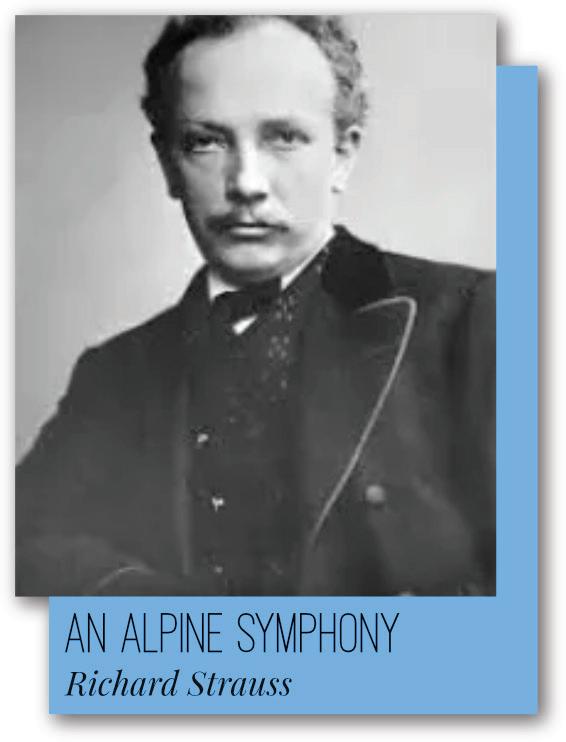
By the time he was forty-five, Richard Strauss was already a world renowned musical figure. His large-scale symphonic poems and spectacular operas had brought him much fame-as well as occasional notoriety. An astute businessman, he had, by this time, amassed a fairly sizeable fortune. Among his most prized possessions was the lavish villa which he had built in the Bavarian town of GarmischPartenkirchen, near the Austrian border. Though imposing in its own right, the villa was situated so as to incorporate as its backdrop a considerable expanse of the Bavarian Alps. Looking out the large windows of his workroom, Strauss could see. . . Saturday, February

towering above him, the Zugspitze, one of the most impressive peaks in the entire Wettersteingebirge Range.
In the early months of 1911, Strauss was at a temporary standstill with his opera Die Frau ohne Schatten (The Woman Without a Shadow). His ibrettist, Hugo von Hofmannsthal, had joined the intelligence service of the Austrian Army shortly after the beginning of World War I and now had little time for literary work. Perhaps prompted by the magnificent Alpine scenery that surrounded him, Strauss remembered a mountain climbing experience from his youth. Although a decidedly amateur endeavor, it had not been without some excitement. The party had lost their way during the ascent and, on the return, they had been caught in a sudden storm and received a thorough drenching. Strauss even had subsequently transformed his impressions of this excursion into a piano piece; however, nothing ever came of it. ("Naturally, it had conjured up a lot of nonsense and giant Wagnerian tone-painting," he later frankly admitted to a friend.) Now, to occupy his time, he toyed with the idea of writing an orchestral work in which he would depict in music a similar, but much more idealized, mountain adventure.
Strauss began the piece half-heartedly. "It gives me less pleasure than shaking maybugs off a tree," he confided to friend. Before long, though, he became totally immersed in the score, and worked on it almost exclusively for for the next four years, finally completing it in February of 1915. Eine Alpensinfonie (An Alpine Symphony), as it came to be called, proved to be Strauss's largest orchestral work yet. The fifty-minute score called for an optimum complement of no less than 137 players. Included were quadruple woodwinds and brass, organ, celeste, two harps, and two sets of timpani, as well as such rarities as a heckelphone (a bass oboe), cowbells, a wind machine, and a thunder sheet. To enable the wind players to sustain the long passages and pedal points that he had written for them, Strauss prescribed the use of Samuels'
Aerophor, a recently patented device which, by means of a foot-operated bellows and a long rubber hose, would supply a steady flow of air to the musician's mouth. The first performance of Eine Alpensinfonie took place on October 15, 1915, in Berlin, with Strauss himself conducting the Dresdner Hofkapelle (Dresden Court Orchestra). "Finally, I have learned to orchestrate!" he was said to have exclaimed afterward.
The music follows a quite detailed program consisting of twenty-two episodes which are specifically identified in the score. Moreover, the elements of sonata form that are requisite for a symphony are substantially lacking, and there is little effort made at developing the thematic materials. Instead, these materials are handled more in the manner of the Wagnerian leitmotiv, with each individual theme being associated with a particular element of the program. These themes are expanded upon, recalled, juxtaposed, and even combined, but their use is determined more by the content of the program than by formal symphonic requirements.
Eine Alpensinfonie is a twenty-four hour mountain adventure which begins at night and ends the following night. It is the depiction of a quest in which man is pitted against nature. Included are musical representations of, among other things, an impressive sunrise, an equally impressive sunset, the spectacular Alpine scenery, and a ferocious storm. Also included are the moments of exhilaration, precariousness, reflection, and triumph which the climbers experience during their quest. Eine Alpensinfonie is certainly high adventure on a grand scale; however, there is no cause for fear. The following are the twenty-two sections which comprise Eine Alpensinfonie as they are identified in the score:
Night (low brasses emerge from the dense background and announce the "mountain" theme). Sunrise (a sonorous passage majestically proclaimed by the brasses). The Ascent (a taut,

rhythmic theme introduced by the strings; hunting horns echo in the distance). Entry into the Woods (an extended, lyrical section complete with imitations of bird calls). Wandering near the Brook (the "ascent" theme surrounded by rippling motives from the strings and woodwinds. At the Waterfall (more rippling figurations, these somewhat more powerful). Apparition a theme played by the oboe against harp qlissandi depicts the appearance of the Fairy of the Alps in a rainbow at the base of the falls). In Flowering Meadows (the cellos play the "ascent" theme against pin-points of color provided by the woodwinds and harp). In the Alm (the high mountain pasture is depicted by cowbells, with the English horn imitating the sound of a herdsman piping). Through Thicket and Underbrush the Wrong Way (the "ascent" theme is heard against a complex, chromatic background). On the Glacier (the "mountain" theme is proclaimed grandly by the brasses). Dangerous Moments (fragments of the "ascent" theme are played against a background of tremolo strings and an ominous drum-roll). Upon the Summit (a majestic climax triumphantly proclaimed by the brasses; immediately afterward, the music becomes hushed and awed). Vision (all the major thematic materials reappear; the organ is heard for the first time). Mists Arise (soft, ascending runs by the muted strings). The Sun is Gradually Obscured (a brief, ominous-sounding passage). Elegy (a thoughtful, expressive theme played by the strings). Calm Before the Storm (a passage for clarinet and oboe). Thunderstorm; Descent (pizzicato strings depict the initial falling raindrops; the full orchestra, augmented by the wind machine and thunder sheet, depicts a sudden Alpine storm in all its savage fury; the "ascent" theme is inverted, signalling the beginning of the descent). Sunset (the "sunrise" theme is combined with the "elegy" theme). Ending Sounds (organ and brasses); Night (the long pedal tones of the opening section return to bring the work to a quiet, meditative close).
Kenneth C. Viant Saturday, February
















Friday, March 13, 2026 - 7:30pm Presented By

Experience the groundbreaking soundscapes of one of rock’s most iconic bands reimagined with full symphonic force. The Canton Symphony Orchestra welcomes back Jeans ’n Classics for An Evening of Pink Floyd—a genrebending fusion of classic rock and orchestral power.
Whether you’re a lifelong fan or discovering Pink Floyd for the first time, this concert promises an unforgettable night at the Canton Symphony Orchestra.








Guest Artist
JEANS ‘N CLASSICS





Co-Sponsored By



Over the years returning special guests Jeans ‘n Classics have brought many shows to the Canton Symphony seasons, including the music of Abbey Road, Queen, Billy Joel & Elton John, Michael Jackson, Led Zeppelin, Eagles, David Bowie, Prince, and Fleetwood Mac. Now in their second decade of performing their rich, diverse catalog with symphonies across North America, Peter Brennan’s Jeans ‘n Classics is a star performer in the arts and entertainment scene. Most definitely not a tribute act, the band and singers of world class act Jeans ‘n Classics faithfully interpret the music of legendary rock and pop albums and artists, with their own special and signature flair.






Edward Leonard has established an outstanding reputation for his versatility and interpretation of an extensive repertoire. As founder and Music Director of The Chamber Orchestra of Pittsburgh, he has led the organization to substantial artistic growth since its creation in 2014. His comfort in diverse repertoire results in a conducting prowess and artistic command that spans the centuries. Leonard’s programming as an Artistic Director and conductor extends from new works to masterpieces of the traditional canon, and under his leadership the Chamber Orchestra of Pittsburgh has commissioned a growing series of new works.
Leonard has conducted the world premieres of pieces by Alyssa Wang, Marina Lopez, and Federico Garcia-DeCastro, as well as the Pittsburgh premieres of works by Amy Williams, Lou Harrison, and Jeffrey Nytch.














Presented By
Participating Sponsors

















THE CANTON SYMPHONY CHORUS Saturday, March 28th, 2026 -

MÉLISSE BRUNET
JESSICA LEIGH BAYNE - SOPRANO

SUNGHOON HAN - BASS-BARITONE
Adean Elegy - 12 Minutes
Gabriela Lena Frank
Intermission - 20 Minutes
A German Requiem - 75 Minutes
Johannes Brahms

Renowned as a conductor of “uncommon emotional intensity” (Marie-Celine) and a “force at the podium”(Eugene Scene), American conductor Mélisse Brunet is a native of Paris, France with Spanish and Italian roots. She is quickly gaining attention on both sides of the Atlantic as “a skilled and polished conductor with an excellent pedigree…Brunet led the orchestra with panache and clarity, giving inspiring and assured renditions of each work.” (Cleveland Classical). In July 2022, she became the fifth Music Director of the Lexington Philharmonic, and the first woman to hold the position. She is also in her fifth season as theMusic Director of the Northeastern Pennsylvania Philharmonic.
Brunet is one of the five conductors featured in the documentary “Maestra”by the Director Maggie Contreras and produced by David Letterman and Melanie Miller (“Navalny”). “Maestra” garnered 2nd place in the 2023 Tribeca Film Festival Audience Award for Best Documentary. The film’s exploration of Brunet’s daring journey at the international La Maestra competition and has received rave reviews in the press, including two articles in the New York Times, the Los Angeles Times, and the Hollywood Reporter.
Jessica Leigh, soprano, is a versatile singing actress comfortable in a wide range of repertoire. Recognized for her artistic honesty and effortless vocal production, she is dedicated to creating an experience through music. This intentionality shines through each performance, whether it be Schumann’s tender “Mondnacht,” Violetta’s fiery “Sempre Libera,” or the heartbreaking “She Used to Be Mine” from Waitress. Ms. Leigh’s interpretation of the soprano solo in Mahler’s Symphony No. 2 was described as “transcendent,” and her rendition of Fantine’s “I Dreamed a Dream” from the hit musical Les Misérables was noted for its “piercing delivery.” She has been part of numerous programs and companies including Opera Columbus, UK Opera Theatre, Opera Maine, Lyric Opera Studio Weimar, Bay View Music Festival, and The Lexington Theatre Company. Performance credits include the title role in Susannah, La Traviata (Violetta), Die Zauberflöte (Pamina), La Bohème (Mimì), Sondheim on Sondheim, and Songs for a New World. In October 2023, she made her debut with the Lexington Philharmonic Orchestra as soprano soloist for Carmina Burana and appeared with them again in March 2025 for Poulenc’s Gloria.







Sunghoon Han is a bass-baritone from Seoul, South Korea, currently in his first year in the Lindemann Young Artist Development Program. During the 2024–25 season, he will perform in the Program’s Patron Concert of opera scenes, Met Orchestra Workshop with Maestro Yannick Nézet-Séguin, and the annual spring recital series held at the New York Public Library for the Performing Arts. Recent operatic engagements include Bartolo in Le Nozze di Figaro and Marco in Gianni Schicchi at Aspen Opera Theater, Gremin in Eugene Onegin and Nardo in Mozart’s La Finta Giardiniera at Indiana University, and several roles at Yonsei University including Don Alfonso in Così fan tutte and Leporello in Don Giovanni. On the concert stage, he has appeared as the bass soloist in Verdi’s Requiem with the Carmel Symphony and in Haydn’s Missa in Tempore Belli with Yonsei University. He made his Carnegie Hall debut in 2024 as part of a Yonsei University alumni concert featuring standard works by Mozart, Verdi, and Brahms as well as Korean composers including Du-nam Cho, among others. He is an alumnus of the Aspen Opera Theater and VocalARTS Program, where he was a Renée Fleming Artist Fellow, and Korea National Opera Studio
Permanently founded in 1983 by then music director Dr. Jeffrey H. Brandes, the CSO Chorus is an auditioned choral ensemble composed of all volunteer vocalists from the greater Stark County area. Chorus members come from all walks of life and have a wide array of choral experience levels. They are united by their love of music and strive to create a remarkable experience not only for the audience but also for themselves.
The view from the top of the stage, looking out towards the audience over a 60-piece orchestra is indescribably profound. Members of the chorus are able to sing with not only the Canton Symphony Orchestra, but also with some of the industry’s most renowned soloists and ensembles. Members have plenty of instruction and support to prepare for more difficult pieces, as some concerts feature choral parts in different languages, such as German, Italian, French, and more. The group is not just a supplemental piece to the CSO–it is its own community program that is meant to educate and support vocalists looking for a place to sing.

The Elegia Andina (Andean Elegy) was composed by Gabriela Lena Frank in 2000, describing it as “a modest tone poem that evokes the majesty and strength of the towering Andes Mountains.”
Dedicated to her older brother, Marcos Gabriel Frank, recalling that “as children of a multicultural marriage (our father being Lithuanian-Jewish and our mother being Chinese-Peruvian-Spanish), our early days were filled with Chinese stir-fry cuisine, Andean nursery songs, and frequent visits from our New York-bred Jewish cousins. As a young piano student, my repertoire included not only my own compositions that carried overtones from Peruvian folk music but also rags of Scott Joplin and minuets
by the sons of Bach. It is probably inevitable then that as a composer and pianist today, I continue to thrive on multiculturalism.”
Elegía Andina(Andean Elegy) “is one of my first written-down compositions to explore what it means to be of several ethnic persuasions, of several minds. It uses stylistic elements of Peruvian arca/ira zampoña panpipes (double-row panpipes, each row with its own tuning) to paint an elegiac picture of my questions. The flute part was particularly conceived with this in mind but was also inspired by the technical and musical mastery of Floyd Hebert, principal flutist of the Albany Symphony Orchestra. In addition, as already mentioned, I can think of none better to dedicate this work to than to "Babo," my big brother — for whom Perú still waits.
Gabriela Lena Frank




Johannes Brahms was very much a person who valued his privacy, a characteristic that became increasingly more pronounced as he grew older and his youthful seriousness turned to gruffness, and eventually, to downright irascibility. Rarely did he invite visitors to his lodgings, an atrociously furnished threeroom “bachelor’s quarters” on the third and topmost floor of a house in Vienna, and Frau Truxa, his formidable landlady and housekeeper, was quite adept at keeping autograph seekers and curious strangers at bay. Next to nothing is known about his religious…

practices other than that he came from North German Protestant stock. He was said to have read the Bible occasionally, but there is no evidence that he attended with any regularity the services of a particular church or denomination. Neither did Brahms “wear his heart on his sleeve” in his music. He was disinclined toward programmatic works and preferred to write “absolute music” in the traditional classical forms that had withstood the test of time. Thus, Ein deutsches Requiem, or A German Requiem, as it is more familiarly known in English-speaking countries, is a kind of “odd man out” among Brahms’s oeuvre. Not only is it one of his few religiously oriented works, but it also is one of his rare, wholly personal statements that give some indication of the workings of the “inner man.”
Brahms’s German Requiem is not, as might be expected from its title, based upon the text of the traditional Latin Mass for the Dead that had been in universal use throughout the Roman Catholic Church up until the time of the Second Vatican Council of 1962-1965 and had inspired works by Mozart, Berlioz, and Verdi, among others. Rather, it is more like an oratorio or cantata comprised of setting of sections that the composer had selected
Selig sind, die da Leid tragen,
Denn sie sollen getröstet werden.
Matthew 5:4
Die mit Tränen säen, werden mit Freuden ernten.
Sie gehen hin und weinen und tragen edlen Samen und kommen mit Freuden und bringen ihre Garben.
Psalm 126:5-6
from the Old and New Testaments and the Apocrypha of Martin Luther’s German translation of the Bible. In so doing, Brahms concentrated upon what is a universal human experience rather than a narrow, doctrinal one. Apparently seeking to create a non-sectarian text that did not follow any particular liturgy, he avoided all references to the names “Jesus” and “Christ.” Most importantly, Brahms addressed the work to the living rather than to the dead. Consequently, it offers comfort and solace to the bereaved rather than grimly reminding them of the horrors of the End of the World and the Day of Judgment that they, too, will eventually face.
Like most of Brahms’s major works, the German Requiem was slow in coming to realization. Two personal tragedies prompted Brahms to write the work. The first was the death of his friend and mentor Robert Schumann in 1856. The second was the death of his mother whom, despite an unhappy childhood, he loved dearly, in 1865. Brahms originally intended the work to consist of six movements. The first three were performed on December 1, 1867, in Vienna, under the baton of Johann Herbeck, at a concert in memory of Franz
Blessed are they that mourn For they shall be comforted.
They that sow in tears shall reap in joy.
They go forth and weep, and bear precious seed, and come again with rejoicing, and bring their sheaves with them.
Schubert. On that occasion, the timpanist lost his place somewhere in the third movement and made such a botch of his part that the work was actually booed. Much more successful was the sixmovement version of the work that Brahms himself led on Good Friday (April 10), 1868, in the Bremen Cathedral. Soon after this performance, Brahms added the fifth movement—the one with soprano solo—that, as its text indicates, is a clearly a memorial tribute to his mother.
Structurally, Brahms’s German Requiem might be viewed as a massive, nearly symmetrical musical arch in which the conciliatory fourth movement serves as both keystone and emotional climax. The opening and closing choruses, with their shared tonality and parallel texts, have much in common. So, too, do the second, third, and sixth movements, in that they move from images of death and despair to ones of hope and triumph. This, of course, is not they way that Brahms had originally conceptualized the work; however, it is the form in which he ultimately bequeathed it to posterity.
M.J. Albacete
Denn alles Fleisch es ist wie Gras und alle Herrlichkeit des Menschen wie das Grases Blumen.
Das Gras ist verdorret und die Blume abgefallen.
I. Peter 1:24
So seid nun geduldig, lieben Brüder, bis auf die Zukunft des Herrn.
Siehe, ein Ackermann wartet auf die köstliche Frucht der Erde und ist geduldig darüber, bis er empfange den Morgenregen und Abendregen.
For all flesh is as grass, and all the glory of man as the flowers of grass.
The grass is withered, and the flower fallen away.
Be patient, therefore, brethren, unto the coming of the Lord.
Behold, the husbandman waiteth for the precious fruit of the earth, and hath long patience for it, until he receive the early rain and the latter rain.
So be patient.






So seid geduldig.
James 5:7
Denn alles Fleisch es ist wie Gras und alle Herrlichkeit des Menschen wie das Grases Blumen.
Das Gras ist verdorret und die Blume abgefallen.
Aber das Herrn Wort bleibet in Ewigkeit.
I. Peter 1:24-25
Die Erlöseten des Herrn werden wieder kommen und gen Zion kommen mit Jauchzen; ewige Freude wird über ihrem Haupte sein; Freude und Wonne werden sie ergreifen, und Schmerz und Seufzen wird weg müssen.
Isaiah 35:10
For all flesh is as grass, and all the glory of man as the flowers of grass.
The grass is withered, and the flower fallen away.
But the word of the Lord endureth forever.
And the ransomed of the Lord shall return, and come to Zion with songs; everlasting joy shall be upon their heads; they shall obtain joy and gladness, and pain and sighing shall be made to flee.





























Presented By



Saturday, April 25th, 2025 -
















FRANCESCO LECCE-CHONG
ZHAN SHU - VIOLIN

Bal Masqué - 5 Minutes
Amy Beach
Violin Concerto, Op. 14 - 25 Minutes
Samuel Barber
Intermission - 20 Minutes
Hymn for Everyone - 12 Minutes
Jessie Montgomery
The Tender Land Suite - 21 Minutes
Aaron Copland

Zhan Shu joined The Cleveland Orchestra in the 2018–19 season, following positions with the Pittsburgh Symphony Orchestra and the Milwaukee Symphony, where he served as acting associate concertmaster. He has also held concertmaster roles with regional and international ensembles, including guest appearances with orchestras in China, Germany, and the U.S.
As a soloist, Mr. Shu has performed with major orchestras including the Pittsburgh and Milwaukee Symphony Orchestras, and at festivals such as Sarasota and Toronto Summer Music. A native of China, he studied at the Central Conservatory in Beijing, earned degrees from Mannes College and the University of Houston, and completed an artist diploma at Indiana University, where he studied under Mauricio Fuks and Alexander Kerr
American conductor Francesco Lecce-Chong has established himself as a respected leader in the orchestral world through his acclaimed performances, innovative projects, and passionate advocacy for the arts. He was appointed Music Director of two US orchestras, the Eugene Symphony and the Santa Rosa Symphony, before he turned 30. With those groups, he successfully launched several groundbreaking projects, commissioning over a dozen major orchestral works, and building innovative community partnerships. Now, in his seventh season leading the Santa Rosa Symphony, he has grown the orchestra’s reputation as one of the most exciting and important regional orchestras in the US with performances at one of the renowned concert halls in the world, the Green Music Center. In the 2024/25 season, Mr. Lecce-Chong takes on the role of Artistic Partner with the Eugene Symphony, a newly created position which allows him to further develop his artistic vision with the orchestra.






Pianistcomposer Amy Cheney Beach was born on the family farm in Henniker, New Hampshire on September 5, 1867. At a very early age she revealed remarkable musical gifts, causing her mother to fear that her skills would attract unfavorable attention to the child. Despite her mother being a gifted pianist, the child was forbidden to study the instrument, which Amy countered by creating complex melodies in her head. Finally, when the mother’s ban was lifted, Amy began reproducing at the keyboard the many tunes she had created and stored in her memory, fully dressed out harmonically, to the amazement of family and friends.
Since Amy was considered a musical prodigy by professional musicians in the general community, they recommended that she be sent abroad to advance her education at one of the superior schools in France or Germany. Instead, the family moved to Boston in 1875—then one of the musical capitols in America—where Amy’s parents were able to place Amy into the classrooms of several of the finest teachers in the United States. Furthermore, she largely self-taught, studying many printed scores, and learning orchestration from her own translation of the Berlioz’ comprehensive treatise.
Soon enough, her pianistic virtuosity attracted considerable attention, making her a celebrity at the age of sixteen. Two years later, she made her orchestral debut with the Boston Symphony, playing Chopin’s Rondo in E-flat as well as the Moscheles Piano Concerto in G minor, both under the direction of Maestro Wilhelm Gericke. That same year, she married Dr. Henry Harris Aubrey Beach, twenty-five years her senior, who respectfully requested that she thereafter limit her performances to charity recitals. Her entry in the Grove Dictionary records that “the premieres in 1892 of her Mass in E flat by the Handel and Haydn Society in Boston, and of her concert aria Eilende Wolken by the New York Philharmonic Society, were the first occasions on which these organizations performed music by a female composer; and her ‘Gaelic’ Symphony was the first symphony composed by an American woman.” Over forty minutes long, even today this symphony is a challenge to any orchestra willing to risk it.
After her husband’s death in 1910, she resumed an active concert career, touring Europe between 1911
and 1914, playing her Piano Concerto in Hamburg, Leipzig and Berlin, and her symphony in the latter two cities. Upon her return to America, she settled in New York, spending many summers at the McDowell Colony, beginning in 1914. She continued to compose through to the end of her life in 1944, leaving a legacy of over 150 works, mostly for piano, voice, or choir. Amy Beach was a leading representative of the late 19th-century Romantic style cultivated by George Chadwick, Arthur Foote, and others of the Boston School. One of her most important legacies was her status as co-founder of the Society of American Women Composers, laying the groundwork for support of female artists in years to come.
Beach composed only one other piece for orchestra, a vibrant preparatory piece using her own solo piano waltz, Bal Masque’, previously composed in 1893 and published in 1894. In 2017, to honor the 150thbirth anniversary of Beach’s birth, the Women’s Philharmonic Advocacy sponsored a printing of Amy’s orchestration. WhileBal Masquéis perfectly charming as a piano miniature in the salon tradition, the piece is significantly enriched by Mrs. Beach’s colorful orchestral realization.
M.J. Albacete
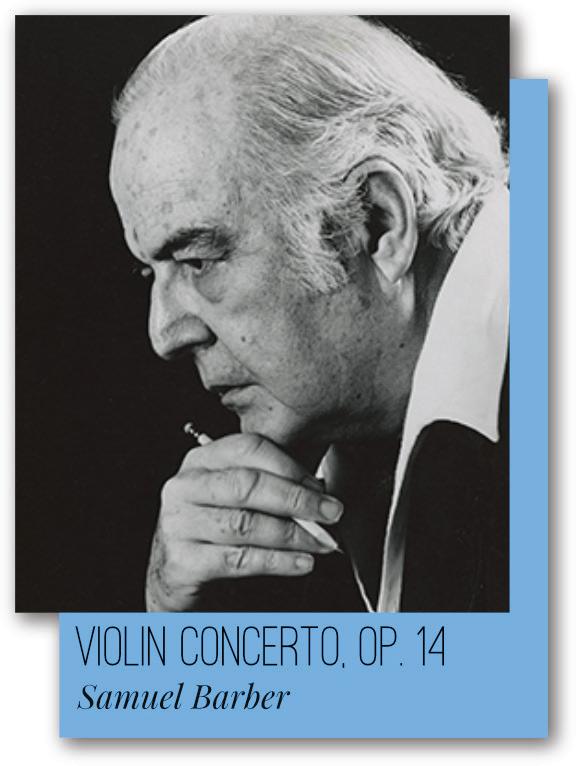
For Samuel Barber, who is generally regarded as being one of the most successful American composers of the past century, the composition of his only violin concerto must have been one of the most
singularly frustrating experiences of his career. Barber was 29 years old in 1939, when he received the commission for the concerto, and was currently enjoying the successes of several recently premiered works, including the Overture to The School for Scandal, the First Symphony, and the First Essay for Orchestra. A rising star on the American musical horizon, Barber had attracted the attention of several prominent conductors, among them the formidable Arturo Toscanini, who was not well known for his support of either modern music in general or American music in particular. The commission for the violin concerto came from Samuel Fels, a prominent Philadelphia businessman and soap tycoon (remember Fels Naphtha?), who desired the work for Iso Briselli, a young Russian-
born violin virtuoso whom he and his wife had recently adopted.
Barber gratefully accepted the commission; then, in the summer of 1939, he departed for Europe, where he intended to work on the score. After brief visits to England and Scotland, he settled in the small Swiss village of Sils Maria and began work on the concerto. Toward the end of that summer, he moved to Paris, where he hoped to complete the work by late autumn. When the Nazis invaded Poland, Barber hastily returned to the United States, bringing with him the first two movements of the concerto.
When Barber showed these two completed movements to Briselli, the violinist, apparently taken aback by their unabashed lyricism and relatively subdued quality, complained that they lacked the brilliance and bravura fireworks requisite for a concerto. Undaunted, Barber promised to make amends for this perceived shortcoming in the finale. Upon seeing the last movement, however, Briselli was even more displeased. Early accounts state that the violinist said the solo part was impossible to play. He later claimed, however, that his objections were based purely on artistic rather than technical grounds. Briselli maintained for the rest of his life that the performance demands of the finale were well within his violinistic abilities; the problem was that the movement simply did not provide either a suitable or adequate balance for the two preceding ones.
The premiere of the work finally took place on February 7, 1941, at the Academy of Music in Philadelphia with Albert Spalding (a scion of the American family of sporting-goods manufacturers) as soloist and Eugene Ormandy conducting The Philadelphia Orchestra.
Barber’s Violin Concerto is representative of the warmly lyrical, neo-romantic style of composition that was his hallmark. Cast in three movements, it consists of two relatively undemonstrative, moderately paced movements in which graceful cantabile episodes prevail that are capped off by a brief but brilliant scherzo-like finale. Written nominally in sonata form, the opening movement, which is marked Allegro, is dominated by the wonderfully expressive melody introduced by the soloist at the very onset. The second theme is a vaguely march-like melody in dotted rhythm and includes a rhythmic figure called the “Scotch snap” (a short note on the beat followed by a longer one that is held until the nest beat). Marked Andante, the central slow movement is melancholy and elegiac in quality. Its principal theme is introduced by the solo oboe, and then taken up by the solo violin. The finale, Presto in moto perpetuo, is a virtuoso tour de force in the form of a perpetuum mobile in which the soloist is required to spin off a virtually uninterrupted flow of triplet sixteenth notes against interjections of cross-rhythms and off-beat accents from the orchestra.
Kenneth C. Viant



Jesse Montgomery is a Grammy awardwinning composer, violinist, and educator whose work interweaves classical music with elements of vernacular music,
improvisation, poetry, and social consciousness, making her an acute interpreter of 21st-century American sound and experience. Her profound works have been described as “turbulent, wildly colorful, and exploding with life,”(The Washington Post) and are performed regularly by leading orchestras, ensembles, and soloists around the world. In June 2024, Montgomery concluded a three-year appointment as the Chicago Symphony Orchestra’s Mead Composer-in-Residence. She was named performer Performance Today's 2025 Classical Woman of the Year.
Montgomery has been recognized with many prestigious awards and fellowships including the Civitella Ranieri Fellowship, the Sphinx Medal of Excellence and Sphinx Virtuosi Composer-inResidence, the Leonard Bernstein Award from the ASCAP Foundation and Musical America's 2023 Composer of the Year. She serves on the Composition and Music Technology Faculty at Northwestern University’s Bienen School of Music.
Of her new composition “Hymn for Everyone,” Jessie Montgomery says that “it is based on a hymn that I wrote during the spring of 2021 that was a reflection on personal and collective challenges happening at the time. Up until that point, I had resisted composing ‘response pieces’ in the pandemic and social-political upheaval, and had been experiencing an intense writer’s block.
But one day, after a long hike, this hymn just came to me—a rare occurrence. The melody transes through different orchestral “choirs,” and is accompanied by the rest of the ensemble. It is a kind of meditation for orchestra, exploring various washes of color and timbre through each repetition of the melody.
M.J. Albacete


Arguably the most “American” of all contemporary American composers, Arron Copland could easily defend that position with a sizeable catalogue of works inspired by American history, folklore and
folk songs. Memorable among these are the three “American” ballets: “Billy the Kid” (1938), ‘Rodeo” (1942), and “Appalachian Spring” (1943-44). His many award winning film scores include those for John Steinbeck’s “Of Mice and Men” and “The Red Pony, Thornton Wilder’s “Our Town,” and Henry James’ “The Heiress.” Copland’s two beloved patriotic masterpieces are “A Lincoln Portrait,” and “Fanfare for the Common Man.”
Born in Brooklyn, New York, on November 14, 1900 to parents of Polish and Lithuanian origins, Copland the fifth child born to the family, and benefited from early piano lessons from an older sister. But for the most part he was self-taught, until he sought out the instruction of several prominent teachers. Thanks to the father’s successful shop and his subsequent election as president of the oldest Synagogue in Brooklyn, the young Copland had the dual benefits of his own cash allowance, and residency in a thriving in a strong cultural community. With plenty of free time, the boy was a “regular” at the New York Symphony Concerts and other musical events.
Eventually, European powers of musical influence drew him to Paris, where he came to know many of the composers then active in that lively capital. Visits to other European countries reinforced Copland’s dependance on foreign musical styles, a disadvantage to him upon his return to America. He wanted, more than anything else, to be an American Composer, and dedicated himself to that cause. In the words of William W. Austin, “The deliberate Americanism and the grandiosity were characteristics that recurred in various guises and various combinations throughout his later works” (“Aaron Copland” The New Grove Dictionary, Vol. 4, p. 719.)
M.J. Albacete the
Copland’s creative musical instincts soon embraced nearly all the traditional categories, even including the “edgy” works by composers of the late 20th Century, the world of Jazz, and other contemporary American musical trends. But by the early 1950s, Copland had yet to compose an opera, his only modest venture for the stage being a school playopera “The Second Hurricane” of 1936. This
absence was to be corrected more than a decade later with a commission from Rodgers and Hammerstein, to commemorate the 30th Anniversary of the League of Composers. To this purpose, Copland entered into a collaboration with librettist Horace Everett, whose offering appealed to the composer for its traditional American family farm setting, “The Tender Land.” The opera was completed between 1952 and 1954, just in time for its premiere on April 1, 1954, with the New York City Opera conducted by Thomas Schippers. With considerable revisions, the opera was presented in its final three-act form at the Oberlin Conservatory of Music, Oberlin, Ohio.
In her notes for the re-release of several Copland items conducted and recorded by the composer including the Suite extracted from “The Tender Land,” Susan Elliot provides a synopsis of the plot: “The Tender Land” is set in the 1930’s and involves a farm family—a mother, her two daughters and a grandfather. It is spring harvest time, and two drifters arrive seeking work. One of them falls in love with the elder daughter, and after her highschool graduation party, they agree to run off together. But he changes his mind and steals away into the night with his fellow hobo. The jilted daughter ultimately decides to leave home anyway; at the opera’s end, her mother looks to the younger daughter to continue the tradition of the family.”
From the score of the opera, Copland extracted three selections for an orchestra suite in 1956: “The Introduction and Love Music” comes from the beginning of the Third Act; the “Party Scene” is from the daughter’s graduation, and the “Finale: The Promise of Living” is an orchestral version of a quintet closing Act I. Fritz Reiner and the Chicago Symphony gave the first performance of the Suite on April 10, 1958, and a year later, on April 23, 1959, Aaron Copland recorded the suite with the Boston Symphony Orchestra.
“The Introduction” has a rather startling “jazzy” bite, with a brilliant, trumpet fanfare; this quickly dissolves into the “Love Music,” haunted by a prevailing sense of uncertainty, of disappointment, even of tragedy hovering over it. Not so with the rollicking “Party Scene,” calling to mind a comparison with Bernstein’s later “Dance at the Jym” episode in “West Side Story”; and the “Finale: The Promise of Living,” provides a redeeming sense of hope: the mother having lost the older daughter, she “looks to the younger daughter to continue the tradition of the family.”










The Employers Health Pops Series comes to a close with an epic season finale as the Canton Symphony Orchestra shares the stage with Grammy Awardwinning artist and proud Canton native Macy Gray.
For Gray, this homecoming concert is more than just a performance—it’s a celebration of the city that shaped her.




















Macy Gray (born in Canton, Ohio) is an American singer, songwriter, and actress known for her distinctive raspy voice and versatile fusion of genres including R&B, soul, jazz, and pop. Gray gained international fame with the release of her debut album, On How Life Is (1999), which featured the chart-topping hit single “I Try.” The song earned her a Grammy Award for Best Female Pop Vocal Performance and firmly established her as a significant figure in contemporary music.
With over ten studio albums to her name, including The Id (2001), The Trouble with Being Myself (2003), and Ruby (2018), Macy Gray has continually evolved as an artist while staying true to her unique sound. In addition to her successful music career, she has collaborated with a wide range of artists, including Bobby Brown, Ariana Grande, and Galactic. Gray has also ventured into acting, with notable appearances in films such as Training Day, Spider-Man, and For Colored Girls.
In 2023, Gray released The Reset, a collaborative album with The California Jet Club, further cementing her musical legacy. Her recent work continues to showcase her innovative approach to music, with the 2024 single “I AM” featuring Big Freedia, marking another exciting chapter in her career.








Jason Seber is known for his inviting and engaging approach on and off the podium. A strong believer in the eclectic experiences which today’s symphony orchestras offer their communities, he strives to make music of many genres and styles accessible, relevant, and meaningful to diverse audiences across the country.
A passionate advocate for music education, Seber has led the Honors Performance Series Orchestra in concert at Carnegie Hall, Sydney Opera House, and Royal Festival Hall in London.
He is a frequent guest conductor of the National Repertory Orchestra each summer and he has served as the All-State Orchestra conductor for Georgia, Kansas, Missouri, and Pennsylvania.


Before Employers Health became a nationwide group purchasing organization, it began right here in Stark County with local employers working to reduce health care costs. Now, Employers Health is honored to support organizations throughout the country and here in Stark County, for the betterment of all communities.





Investing
Learn more about our grant programs and resources, find your next arts experience, or connect: OAC.OHIO.GOV.






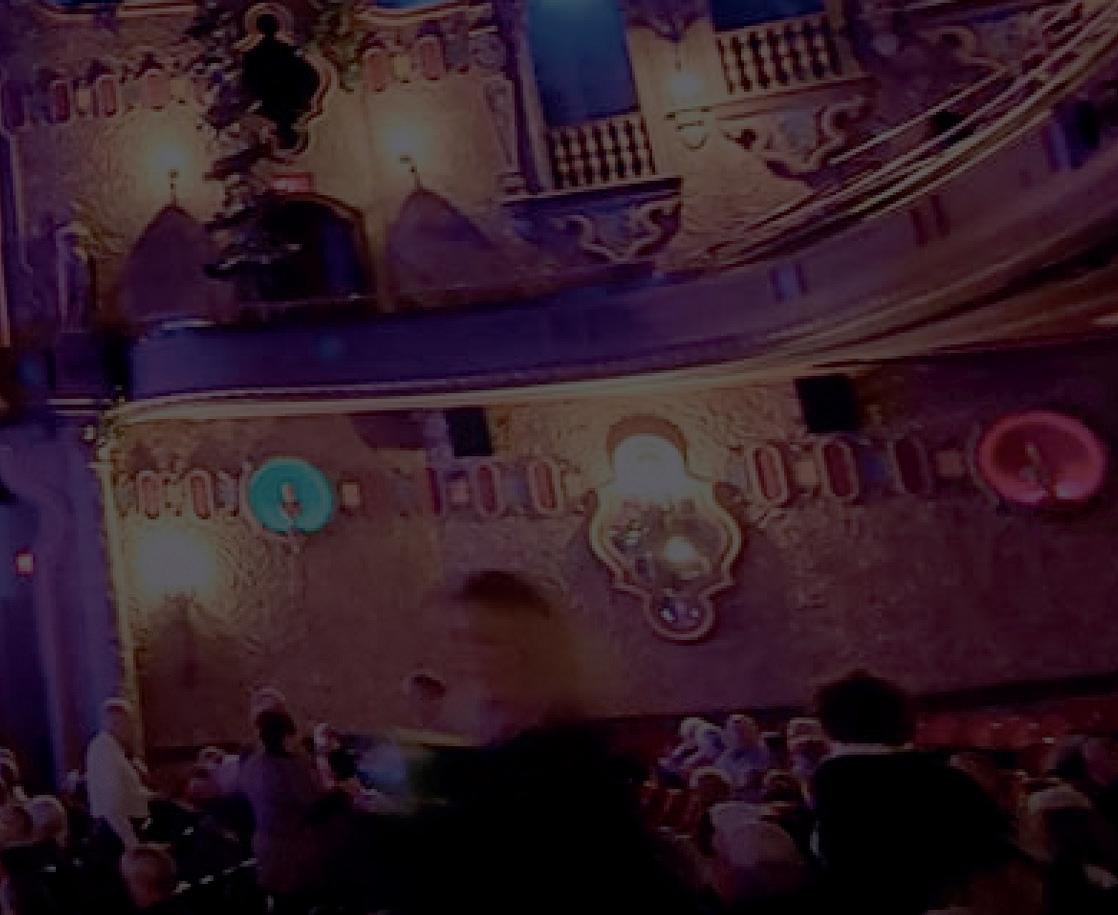



















































VISIT!
The Immel Circus
Art & History Galleries
Paul Brown Museum
OHregionalities Shop
TWiLite Café
Sensory Room



INTERACT!
Art Classes & Workshops
Tours & Speakers’ Bureau
Brown Bag Lunches
History Discussions
History Happy Hour
Rental Spaces

admission
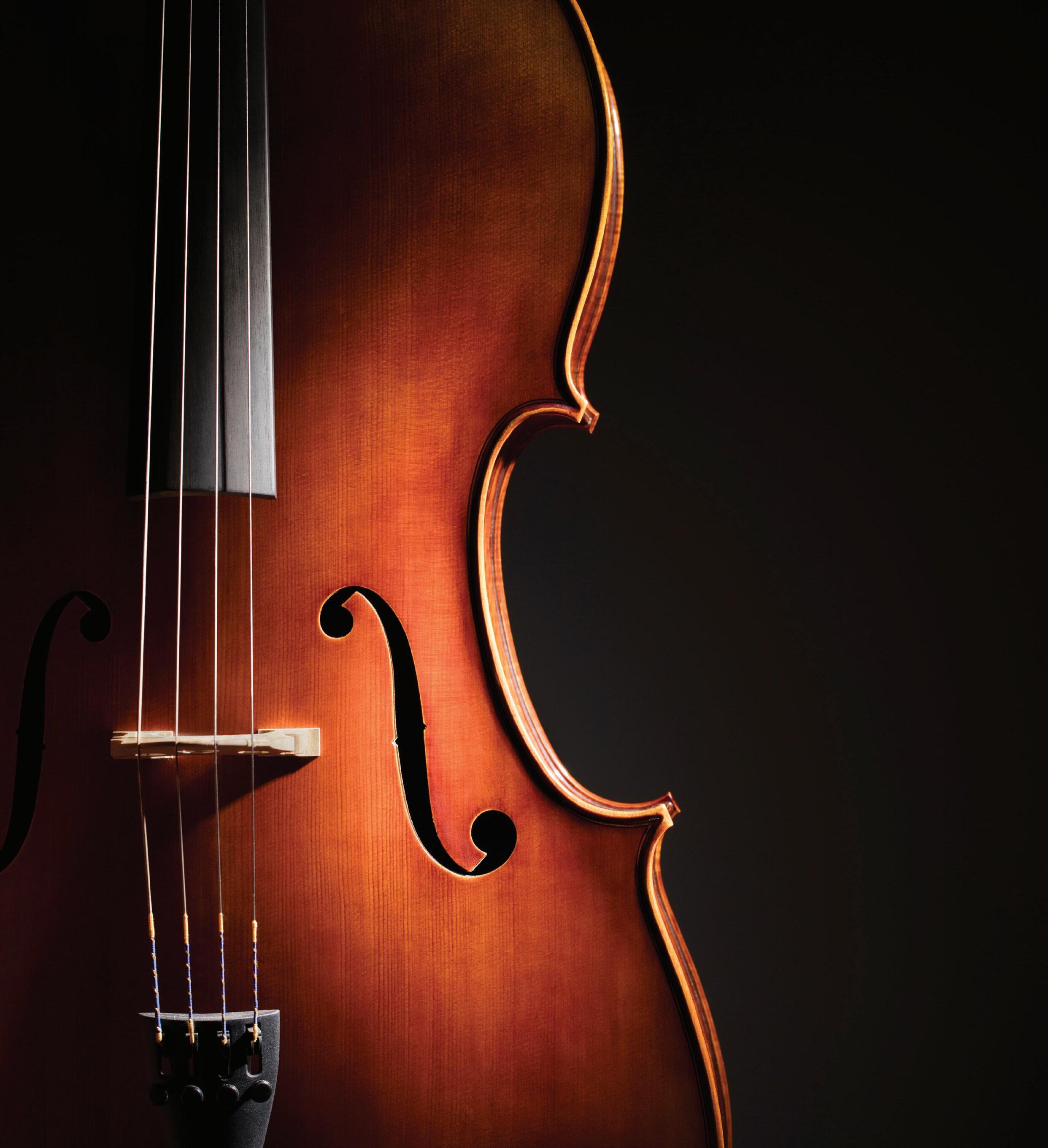











Featured Exhibition
Plein Air from the CMA Collection
Featuring the light, colors, and moods of the outdoors, this exhibit highlights artists such as Winslow Homer and Andrew Wyeth who let nature be their muse.
Impressions En Plein Air
A juried selection of Impressionist-style paintings by the Ohio Plein Air Society.
Estuaries: The Creative Habitats of Erin Mulligan
Narrative oil paintings with imaginative characters inspired by curiosity and the human experience.
Stories Worth Painting: Augusto Bordelois
Immigration and the American Dream play heavily in this Cuban-born, Cleveland artist’s thoughtful work.













Apr 28 - Jul 26, 2026
Featured Exhibition Reclaimed: The Art of Recology
The exhibit presents a fascinating survey of 33 artists who created meaningful and thoughtprovoking artworks in a variety of media through San Francisco’s waste management service, Recology. Organized by the Bedford Gallery at the Lesher Center for the Arts, Walnut Creek, CA.

Net Worth: Ben Lambert Ceramics
Ohio-based artist, Ben Lambert, hand builds ceramic sculptures that take the form of stylized figures and animals that reflect the problematic relationship between humans and the natural world.
On the Threshold of the Great Lakes Artist Geo Rutherford’s mixed-media works explore themes of invasiveness, impermanence, and the unseen aspects of the Great Lakes ecosystem.
Earth, Fire, Water: The Elements of Watercolor & Ceramics
Featuring many pieces from CMA’s acclaimed collection of watercolor and ceramic masterworks, Earth, Fire, Water showcases how the elements work together in the creative processes to produce stunning results.
Nov 25, 2025 - Mar 1, 2026
& CMA’s 90th Anniversary
Shattered Glass is an original exhibition by CMA showcasing American female artists from the past 250 years who made a lasting impact on the art world.
The artists in the exhibit have fought for their right to create art alongside male contemporaries and while doing so, revolutionized the field. This exhibit shines a light on these artists and their enormous contributions.
CMA has worked with museums and private collections nationwide, and drawn from its own Collection, to assemble more than 100 major works and inspiring stories never before experienced in one place.
With related exhibitions and programs in 2025-26 from: Canton Ballet | National First Ladies Library & Museum | Massillon Museum McKinley Presidential Library & Museum | Stark Library Visit CantonArt.org/shattered-glass to learn more!









support is a
that cannot be imitated.
thank you for allowing us to come together to inspire our own works of art. aultman.org aultcare.com
